The hydropower industry and epoxy coatings page 10
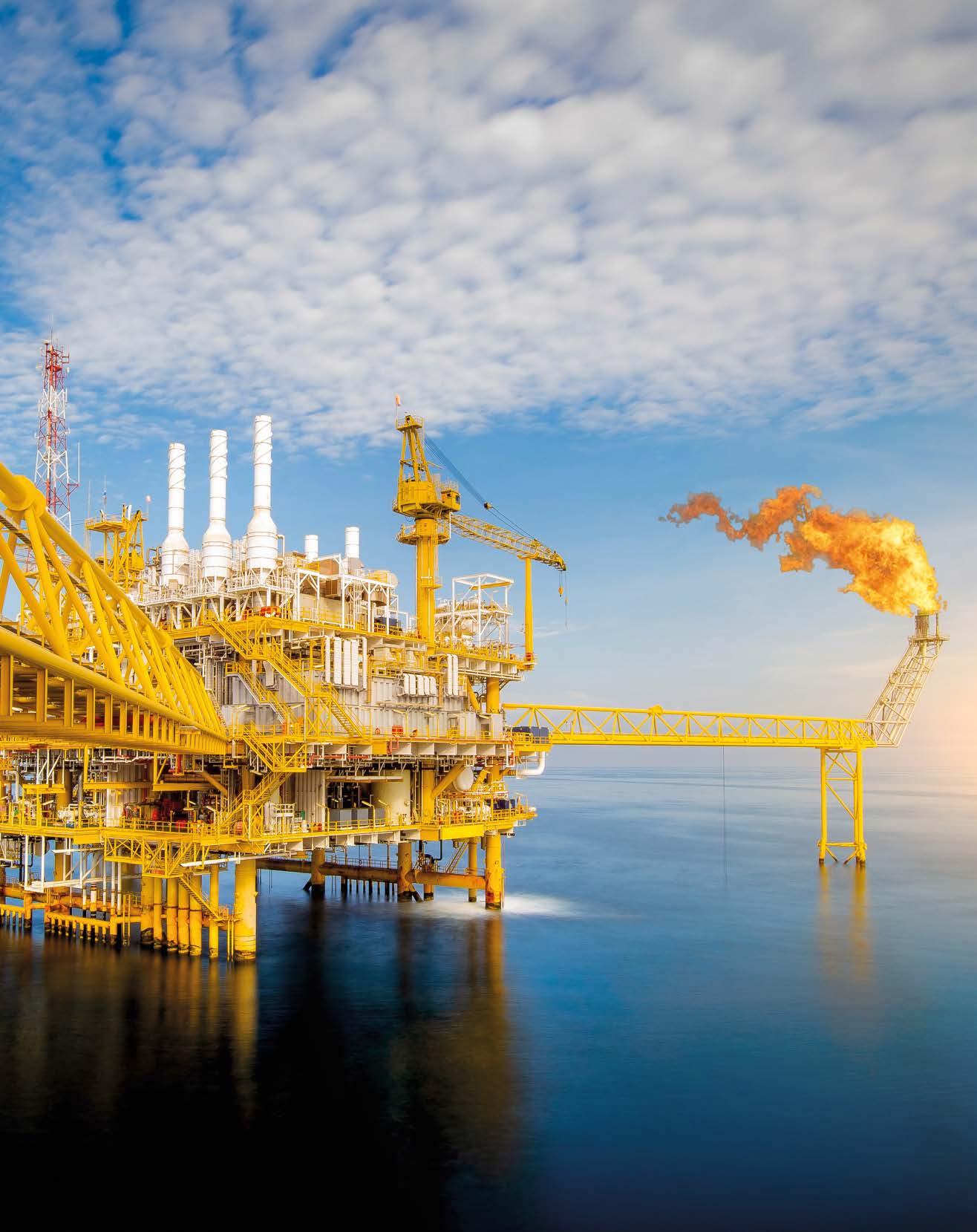
Micro-cracks caused by corrosion under insulation in France’s nuclear power plants page 28
tale of the sea page 34
ISSUE 2 APRIL 2023 an ipcm® magazine
ISSN 2282-1767 © Adobe Stock
A


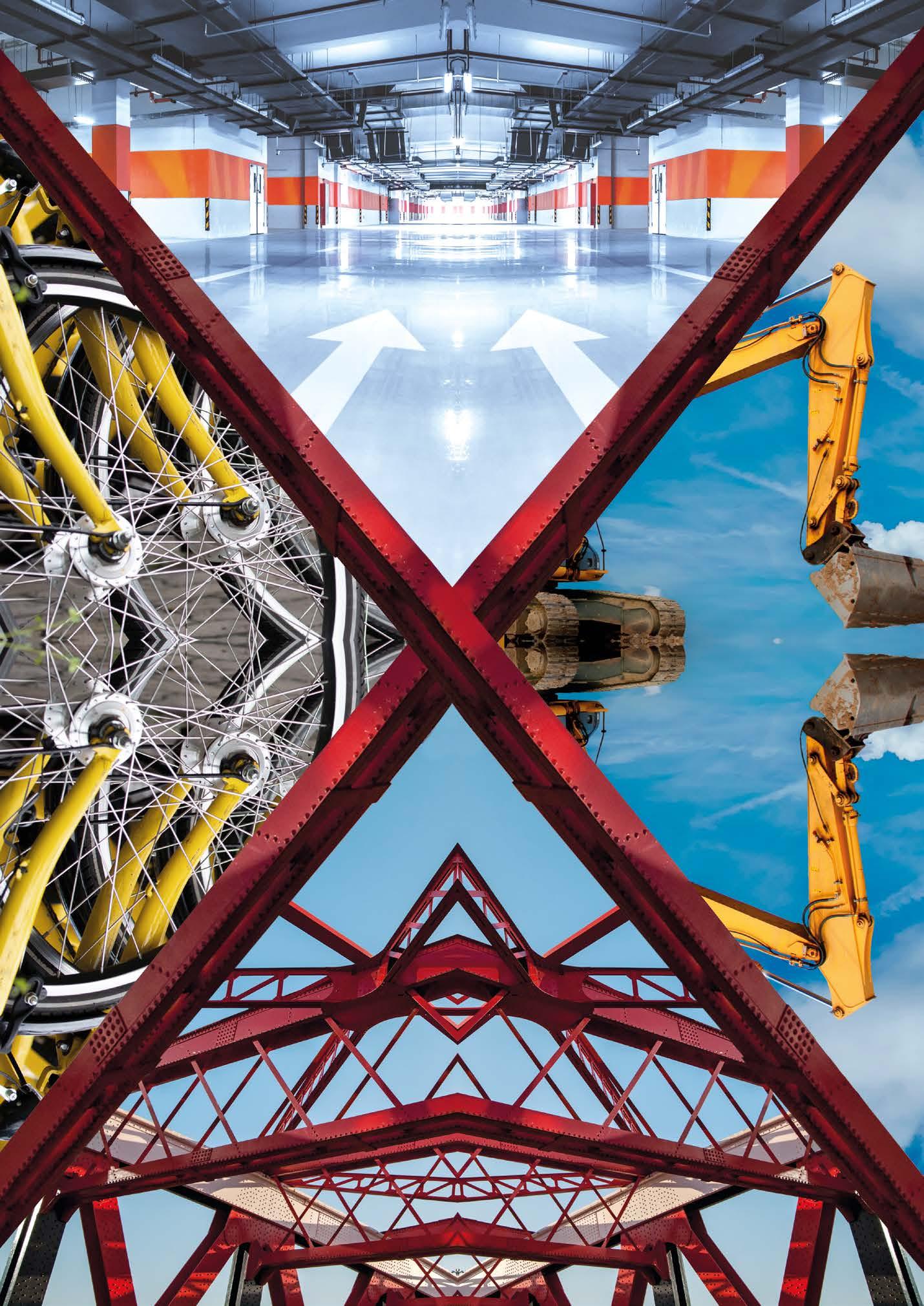
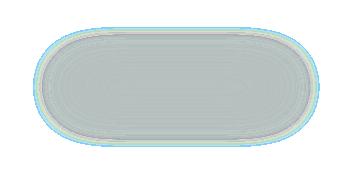
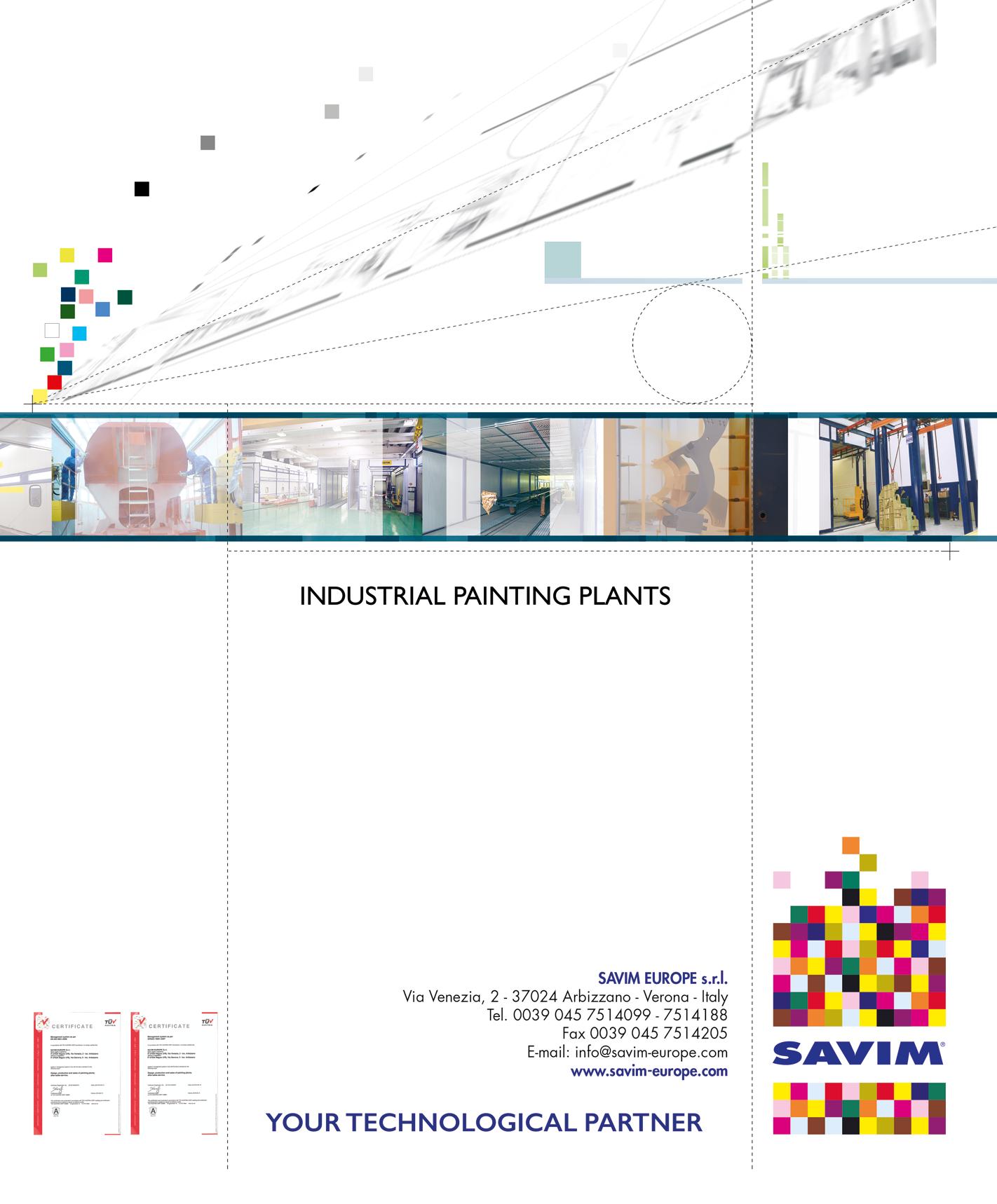


Achieve
14
The hydropower industry and epoxy coatings
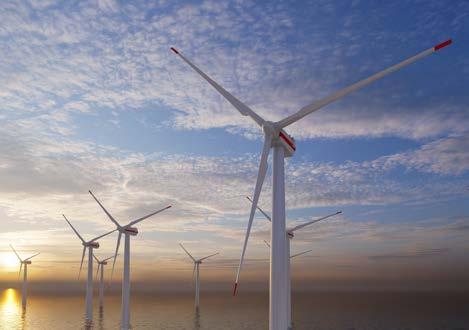
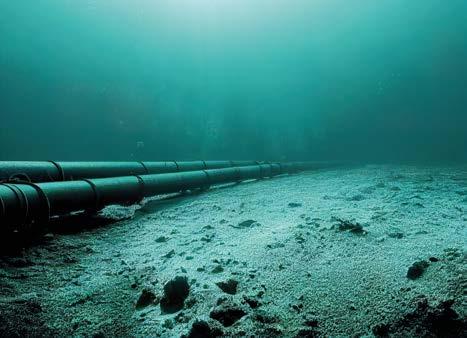
Bristle Blaster®: innovation in surface preparation 20

High corrosion protection, excellent edge coverage: FreiLacke develops a new polyester system based on Primid
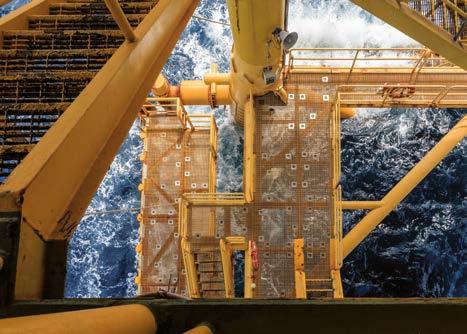
Zentek
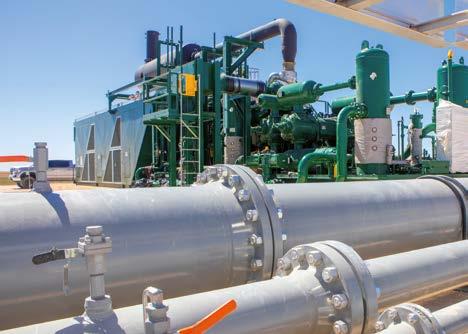
01 FROM THE EDITOR 02 WHAT'S NEW 06 ADVANCEMENTS
SUCCESS STORY
faster installation, less downtime with temporary coatings for flanges 10
ADVANCEMENTS
ADVANCEMENTS
RESEARCH BREAKTHROUGH
operation and maintenance costs of offshore wind turbines
ROAD TO 2050
SIGMAGLIDE
marine coating delivers dramatic power savings and emissions reductions 28 THE BREAKDOWN
22
Reducing
26
PPG
2390
in France’s nuclear
plants 32 ADVANCEMENTS
Micro-cracks caused by corrosion under insulation
power
introduces a novel corrosion protection technology: ZenARMOR™ 34 SCIENCE OUTLOOK A tale of the sea 42 SUCCESS STORY Highest corrosion protection for the photovoltaic industry 44 VOICES A life for the Great World of Surfaces 48 RESEARCH BREAKTHROUGH New corrosion protection that repairs itself 52 SUCCESS STORY
flake coatings could mean end to offshore wind substructure surface maintenance 54 SUCCESS STORY
composite repair solution for offshore risers reinforcement 56 SCIENCE OUTLOOK
general corrosion attack in quenched and tempered steel: the
of inclusions 60 MEETING THE INDUSTRY 67 WHERE WE'VE BEEN ISSUE 2APRIL 2023 CONTENTS 06 22 48 54 34
Glass
High-performance
Local intensification of
role
23-25 May 2023 Ravenna, Italy




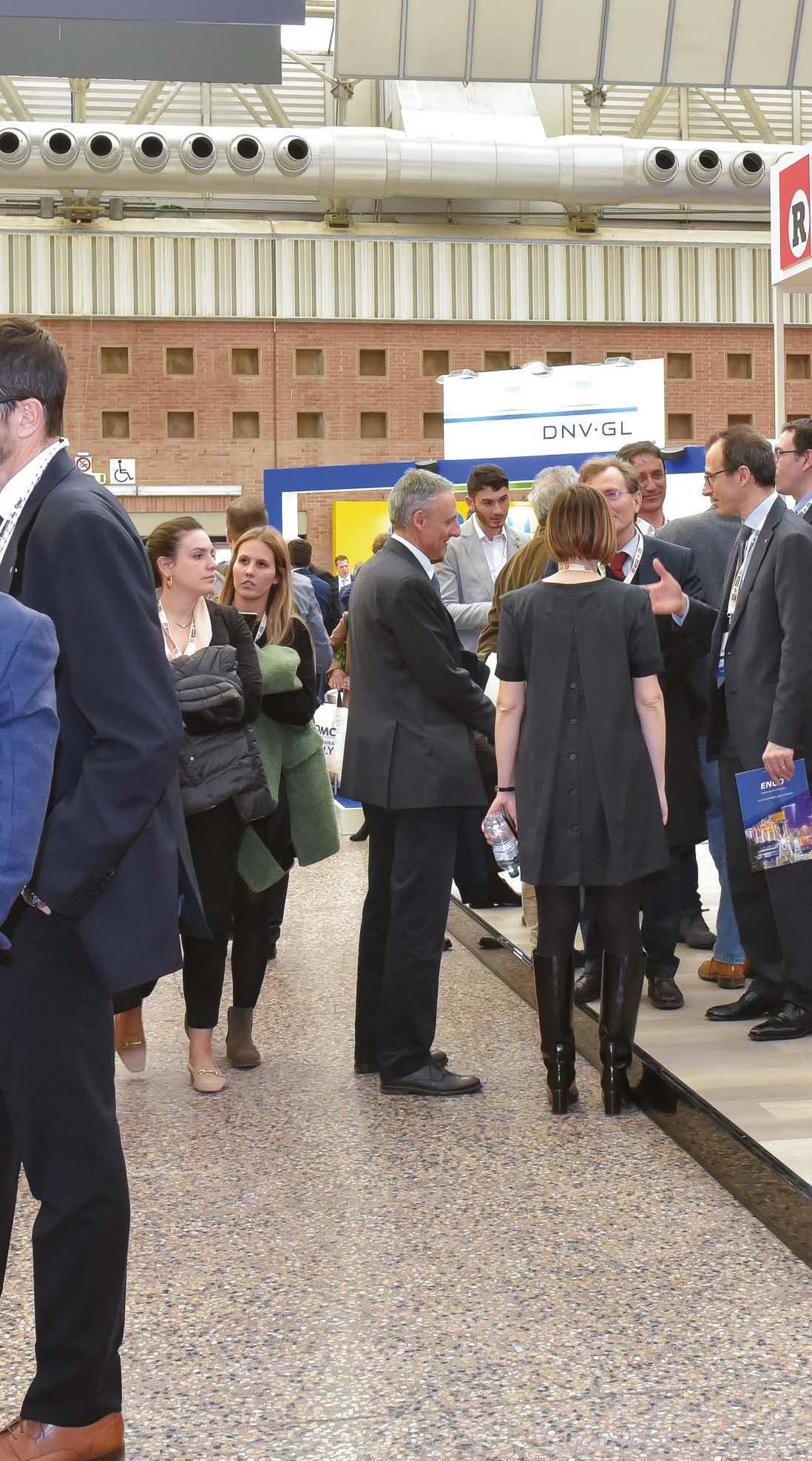
25
550
SPACE BOOKING exhibition@omc.it CONFERENCE REGISTRATION conference@omc.it Register at www.omc.it
EXHIBITION
and sustainable technologies, open dialogues between companies and institutions, to exchange know-how and experiences in the energy transition path. Join the change, discover the solutions.
ORGANISED BY FOUNDERS ASSOCIATED COMPANIES 18.000 VISITORS 1.200 CONFERENCE DELEGATES 22 SPONSORING COMPANIES 40 MEDIA PARTNERS
SUPPORTING ASSOCIATIONS
EXHIBITING COMPANIES
MED ENERGY CONFERENCE &
Innovative
•
Cyclomix® Evo, the brand new solution for

2&3 components mixing and dosing

•
With the Cyclomix® Evo solution, you are guaranteed to get the best out of your production tool with:
PERFECT DOSING AND MIXING with an accuracy of +/- 1%, thanks to a patented injection system for all types of products (for waterborne, solvent-based, acid, epoxy, polyurethane paints, etc.).
HIGH PRODUCTIVITY
THE BEST CHOICE OF PRODUCTIVITY AND PEACE OF MIND!
by the management of 2 independent circuits: rinsing and priming is possible during production. An intuitive interface that requires only 2 minutes of training which can evolve according to your needs by adding new features throughout the life of your Cyclomix® Evo.


OPTIMISED MANAGEMENT OF WASTE
of mixed paint and used solvents thanks to the «paint optimisation» function with optional collection of mixed paint, dirty solvents. Reusable solvents can be used a second time to dispose of the mixed paint.
Discover our solutions www.sames.com contact: marketing@sames.com
Real time supervision via a Smartphone app with piloting control of the machine
Notification in case of alarm
Monitoring of production and maintenance data to optimise your production
Alessia Venturi Editor-in-chief

For some years now, the energy sector has been experiencing a green acceleration: the use of fossil fuels is still widespread, but the diversification of the energy mix is gradually improving, as the world, especially Europe, is working to increase the share of renewable energy available for consumption. Irrespective of their location, all oil and gas companies are looking for ways to reduce emissions in their processes – the European one by proactively seeking to replace fossil fuels, the US ones by focusing primarily on removing carbon emissions from existing operations1 (e.g. through “carbon sequestration”). Investment in the oil sector is still going to be very high for the next three to five years, driven by the reopening of China after the pandemic. However, the global energy crisis of the last two years has undoubtedly triggered unprecedented momentum in favour of renewables, and the International Energy Agency predicts that in the next five years the world is going to produce as much renewable energy as it has in the last two decades. By 2025, renewable energy is going to overtake coal as the main source of electricity generation worldwide2. This phase of energy transition towards environmentally friendly solutions poses major challenges in terms of new infrastructures or adaptation of existing ones to new energy sources and production methods. Thanks to continuous innovation, renewable energy production plants are becoming increasingly efficient and competitive. For example, wind turbines today reach diameters of 200 metres, and their size is expected to grow further3 Newly constructed pipelines are designed to
1 https://www.advisoronline.it/asset-manager/gestori-e-mercatifinanziari/69620-settore-energetico-5-trend-per-il-2023.action
2 https://www.inabottle.it/it/tendenze/energie-rinnovabili-trend-2023
3 https://www.enelgreenpower.com/learning-hub/energy-transition/ renewable-energy-sources
be able to also transport green hydrogen (an energy carrier – not a source – that can only be obtained from renewable sources) in future, so that will be still able to be used once the energy transition is complete. A decisive role is also played by energy storage systems, which are needed to make up for the intermittency of renewable sources such as sun and wind4 All the dynamism that can be detected in the trends of the next five years for the energy sector and in their related energy transition processes has also a huge impact on the sector of corrosion prevention and protection technologies, helping to lengthen the service life of assets but above all to design new infrastructure that is more efficient, durable, and easy to maintain. This Corrosion Protection issue offers a wide-ranging and detailed insight into scientific studies and research, innovative products and success stories of corrosion protection solutions for wind turbines, gas pipelines, solar parks, hydroelectric power plants, and offshore installations: from traditional epoxy systems to innovative glass flake coatings, up to new coatings containing functionalised graphene oxides and self-healing corrosion protection systems. Not to mention the analysis of the parameters for optimum surface preparation and correct design of cathodic protection systems for submerged structures and the case studies on successful maintenance interventions.
A very rich issue, testifying to the importance of investment in renewable energies as an exceptional driving force for research in the corrosion protection industry as well as a great opportunity for economic growth for all industry players.
4 https://www.inabottle.it/it/tendenze/energie-rinnovabili-trend-2023
01 APRIL 2023 | CORROSION PROTECTION
EDITOR FROM THE
A very rich issue, testifying to the importance of investment in renewable energies as an exceptional driving force for research in the corrosion protection industry as well as a great opportunity for economic growth for all industry players.
Carboline announces the release of Hydroplate, a product line exclusively for the water and wastewater markets
Hydroplate high-performance, potable water linings are the ultra-durable solution for protecting the most valuable assets against the damaging effects of corrosion in the new tank construction and maintenance, repair, and operation (MRO) markets. These linings are designed to coat varying types of steel and concrete ground and elevated storage tanks and to provide the ultimate protection for potable water pipes, valves, and fittings. The Hydroplate series includes single and multiple coat linings that offer high solids and near solventfree options, with high-build capabilities, fast cure properties, and the ability for rapid return to service. "The Hydroplate line will continue to build on Carboline's 75-year mission to deliver innovative solutions for protecting and preserving our vital steel and concrete infrastructure assets,” said Jeremy Sukola, the Water and Wastewater Market Manager for Carboline. "They offer varying film builds, real-world application benefits, and other service life-extending attributes."
Hydroplate linings provide superior protection while adhering to the most stringent requirements outlined in multiple AWWA standards and NSF/ANSI/CAN 61- NSF/ANSI/CAN 600 standard that significantly reduces the allowable amounts of certain extractable solvents. Hydroplate potable water linings provide lower overall VOCs than many previous-generation linings while offering an extremely durable and sustainable option for extending asset service life.
"Hydroplate linings provide the robust chemical resistance required in the water and wastewater markets," remarks Paul Atzemis, Carboline's Director of Technical Service. "These products are outstanding options for water storage and the harsh environments found in water treatment plants."
The Hydroplate line of materials offers a variety of film thickness options, from thin film applications under five mils DFT to higher build solutions that exceed 30 mils in a single application. With varying advanced resin technologies, Hydroplate lining options include the ability to cure down to 20 °F (-6 °C), fast recoat and overcoating schedules, and extended maximum recoat windows. These application benefits can help extend the painting season and limit costly project schedule delays.
www.carboline.com
Hexigone’s smart inhibitors reach Mexico via first quality chemicals
Hexigone Inhibitors, a manufacturer of award-winning, patented anticorrosives, announced its exclusive partnership with First Quality Chemicals, leader in distribution of the most innovative and superior specialty chemicals in Mexico. The partnership will bring Hexigone's high-quality products to new customers in Mexico, further expanding the company's reach in the Americas. First Quality Chemicals has over 20 years’ experience distributing specialty chemicals in Mexico and has over 1,000 customers. They are known for their ability to understand customer needs and strive to be “unique, disruptive and different” - aligning with Hexigone’s product and company ethos. "It’s great to expand our sales team via First Quality Chemicals," said Dr Patrick Dodds, CEO of Hexigone. "We’ve already developed great relationships, and I have no doubt that our collaboration will be a successful one. The Mexican coatings market is still in transition from the most commonly used corrosion inhibitors - that have been banned in some other countries - to new technologies. Intelli-ion® will allow regional coatings customers to offer their customers a completely new way of protecting against corrosion as well as reformulating to optimize for performance, sustainability or cost."
Jaqueline Chinas, Awesome Dreams & Innovation Leader at First Quality Chemicals, added: “We are fully committed to providing our customers with the latest technologies and the most innovative solutions to help them achieve their goals and manufacture products that can make the world a better place. We are sure that Intelli-ion® it´s the perfect match for the coatings manufacturers´ formulations.” Hexigone offers a solution to metal asset protection with their high-performance anti-corrosive additives for coatings, providing a safe and cost-effective alternative to traditional heavy metals, phosphates, and toxic chromates. Corrosion inhibitorIntelli-ion®AX1 – protects in a ‘smart’ way and is completely unique to the market. Intelligent micro-reservoirs enable the coatings to react faster to the environment, triggering the release of the inhibitor ‘on demand.’ This innovative technology has caught the attention of coatings industry organisations globally, earning Hexigone ‘Sustainable Innovation of The Year’ from British Coatings Federation in 2022, and ‘Corrosion Innovation of the Year’ from AMPP’s Materials Performance in 2021. The company’s specialty chemical network is growing fast – Hexigone are currently working with 13 distributors across the globe.
www.hexigone.com
02 CORROSION PROTECTION | APRIL 2023 NEW WHAT’S
Huntsman presented new coatings products at ECS

The Belgian company Huntsman launched three new products at the European Coatings Show (ECS), the international trade fair dedicated to paints and coatings that took place from 28th to 30th March 2023 in Nuremberg (Germany).
The new products included POLYRESYST® IC6005 polyurethane system, JEFFAMINE® M-3085 amine and POLYRESYST® IC6005 system. Moreover, the visitors had the opportunity to discover more about the extensive range of polyetheramines of the company, such as the mono-functional JEFFAMINE® M 2070 –which can be used as a reactive dispersant.


POLYRESYST® IC6005 is an intumescent coating specifically developed for the construction industry, in order to provide passive fire protection performances alongside corrosion protection properties. Suitable for use on a variety of substrates, the polyurethane system can offer improved chemical and water resistance, as well as durability. Besides containing no added solvents and low VOC levels, it also cures quickly at any desired thickness.
Huntsman also presented the new JEFFAMINE® M-3085 mono-polyether amine with a higher molecular weight than the commonly employed solutions, so it can be used as a raw material for the synthesis of pigment dispersants or as a building block in reactive surfactants for the emulsification or dispersion processes of epoxy resins in water. Finally, the company showcased its new POLYRESYST® IC6005 system on an I-beam, a cross laminated timber panel and a series of tiles. In addition, the visitors of the trade fair ECS were able to experience two keynote speeches from the coating experts of Huntsman:
‘The use of mono-functional polyetheramines in waterborne epoxy resins’ by the application specialist Steven Buvens on Tuesday 28th March 2023.
‘Novel Fast Curing Intumescent Polyurethane Coating System’ by the technical manager Stefan Priemen on Wednesday 29th March 2023.
www.huntsman.com


WHAT'S NEW
PPG presented Steelguard 951 fire protection coating for the architectural market
The international coatings manufacturer PPG has recently announced that it will launch PPG Steelguard® 951, an innovative epoxy intumescent coating that has been specifically developed to meet the demands of modern architectural steel, providing up to three hours of cellulosic fire protection.
In the case of a fire, the 100% solids coating expands from a thin and lightweight film into a thick foam-like layer that insulates the steel and maintains its structural integrity, providing more time for people to escape and limiting damage to buildings and assets. PPG Steelguard 951 coating also provides effective corrosion protection even in severe atmospheric environments, up to ISO 12944 C5, without the need for a top coat.
In addition, it reaches up to 3,500 microns dry film thickness in a single coat and cures rapidly, making it ready to handle the day after application.
“Structural steel plays a critical role in modern architecture by
enabling buildings to meet specific fire protection and corrosion resistance according to their function. PPG Steelguard 951 coating is unique in combining an aesthetically-pleasing finish with high corrosion protection and, most importantly, the ability to maintain the steel’s stability in the event of a fire,” has stated Richard Mann, the global passive fire protection product manager for the Protective and Marine Coatings division of PPG.
PPG has designed the new intumescent coating using its patented flexible epoxy technology, which offers durability and edge retention properties that reduce the risk of cracks caused during handling and transportation. It is tested in accordance with all recognised national and international fire and corrosion standards, including EN 13381-8, BS 476, ISO 12944, GB 51249 and GB14907 (for specified environments).
www.ppgpmc.com
A new topcoat - and even more innovation
Fastener Fair Global 2023, the big meet-up for the fastener technology industry, is over. A wide range of manufacturers, distributors and suppliers came together to showcase their technologies and innovations on more than 23,000 square metres, including DÖRKEN, a supplier of high-performance corrosion protection, who presented a new product innovation. The new topcoat from DÖRKEN, DELTA-PROTEKT® TC 502 GZ stands out thanks to the fact that it has a very narrow friction coefficient window, it is PTFE-free and it ensures strong process stability. This silver, water-based topcoat is therefore ideal for components with metric threads, such as screws and nuts, and meet the demands made by customers for a topcoat of this kind. In combination with a basecoat, DÖRKEN’s latest solution offers effective corrosion protection with additional multifunctional properties, and also provides cathodic corrosion protection. Here, the less noble zinc contained in the coating sacrifices itself in favour of the more noble steel, thereby ensuring that the component remains protected, even if the coating is damaged, as the zinc dissolves more rapidly. Whilst the basecoat is primarily responsible for protection against corrosion, other properties that are important for a wide variety of components can be added via the topcoat. The very narrow friction coefficient window and high process stability ensure that processes always proceed in the same way to guarantee consistently high-quality results. This makes processes easier to plan, more efficient and less susceptible to unforeseen events. DÖRKEN also bears sustainability very much in mind with the new topcoat. By avoiding polytetrafluoroethylene (PTFE), the
company is specifically thinking about the future of the coating industry as well as the environment.
But innovation is more than just developing new product solutions. When it comes to coating technology, DÖRKEN also works closely with its partners, for example, the companies EJOT and WMV. EJOT, a specialist in fastening technology, was looking for a standard for coating screws with internal drives. In the case of the micro screws, which are used in a large range of industries, coating accumulations occurred in the drives from time to time, and this had a negative effect on the bit accessibility of the screws. As a result, safe assembly was not necessarily ensured.
The collaborative efforts of the companies EJOT, DÖRKEN and WMV, a plant manufacturer specializing in surface treatment, took many years. But the time invested paid off in the end: a new type of coating system, in which the parts are ideally coated, was created. The system, called PULZ®, operates with a permanent circulation of the components, which are thus coated evenly and with thin layers. It is the first system in the world that can coat 120 kilograms of material at 32 g acceleration with a change in position. In addition, optimization has made it possible to establish a process in which CO2 emissions are reduced by 30 per cent compared to before. Be it new coating solutions or new innovations in plant engineering - wherever there are innovations in the field of coatings, DÖRKEN is not too far away. Always close to the customer, always with sustainability in mind.
www.doerken.com
04 CORROSION PROTECTION | APRIL 2023 WHAT’S NEW
Hempel joins IMO public-private partnership to help prevent biofouling on ships’ hulls

World-leading coatings company, Hempel A/S, has increased its commitment to supporting the maritime industry’s shift to ever more sustainable operations by joining the Global Industry Alliance (GIA) for Marine Biosafety. The GIA, created under the International Maritime Organization’s (IMO’s) GloFouling Partnerships project, is a crosssectoral platform for collaboration. Following Hempel’s membership, the GIA comprises 13 private companies that work with governments, the IMO and other non-governmental organisations to increase awareness of the environmental implications and risks associated with biofouling on ships hulls, identify common issues, and foster solutions for mitigation. The alliance also informs policy developments and shares technical expertise within NGOs. “At Hempel, we are very pleased to be joining the GIA for Marine Biosafety. We believe that strong collaboration between all stakeholders - governments, NGOs and the maritime industry - is needed to identify challenges and accelerate solutions to decarbonise the maritime industry and protect marine environments. As a provider of hull performance solutions that can help prevent the build-up of invasive species on hulls as well as reduce the fuel usage and carbon emissions of ships, we look forward to taking part in this collaboration,” says Alexander Enström, Executive
Vice President and Head of Marine.
Colorful Protection

Biofouling on ships’ hulls can affect the environment in two ways. Ships sailing across different regions can facilitate the unintentional spread of invasive aquatic species one of five largest threats to marine biodiversity. Further, biofouling build-up on a ship’s hull creates drag and can significantly reduce efficiency levels as more fuel is required to propel the vessel through the water. Members of the GIA include marine coatings companies, in-water cleaning service providers and marine growth preventive systems, shipping companies and technical organisations. The International Association of Oil & Gas Producers also has observer status within the group. The GIA was set up as a public-private partnership by the GloFouling Partnerships project in June 2020. The Project is part of the wider efforts undertaken by IMO, in collaboration with the Global Environment Facility (GEF) and the United Nations Development Programme (UNDP), to protect marine ecosystems from the negative effects of invasive species. The programme is also in line with the IMO strategy to reduce greenhouse gas emissions from shipping by at least 50% by 2050. By limiting biofouling on a ship’s hull, GHG emissions are reduced and operational efficiencies can be achieved.
www.hempel.com


WHAT'S NEW
BE CURIOUS! https://digitalcolors.merckgroup.com Merck Srl Electronics Surface Solutions Via Monte Rosa 93 20149 Milano MI | Italia PMsalessupportIT@merckgroup.com tel. 00 800 72771666 www.eshop-merckgroup.com/IT/it NEW
Experience DIGITAL COLORS: explore our latest global mobility color inspirations and stay up to date on our latest novelties about color effects and protective coatings.
ADVANCEMENTS
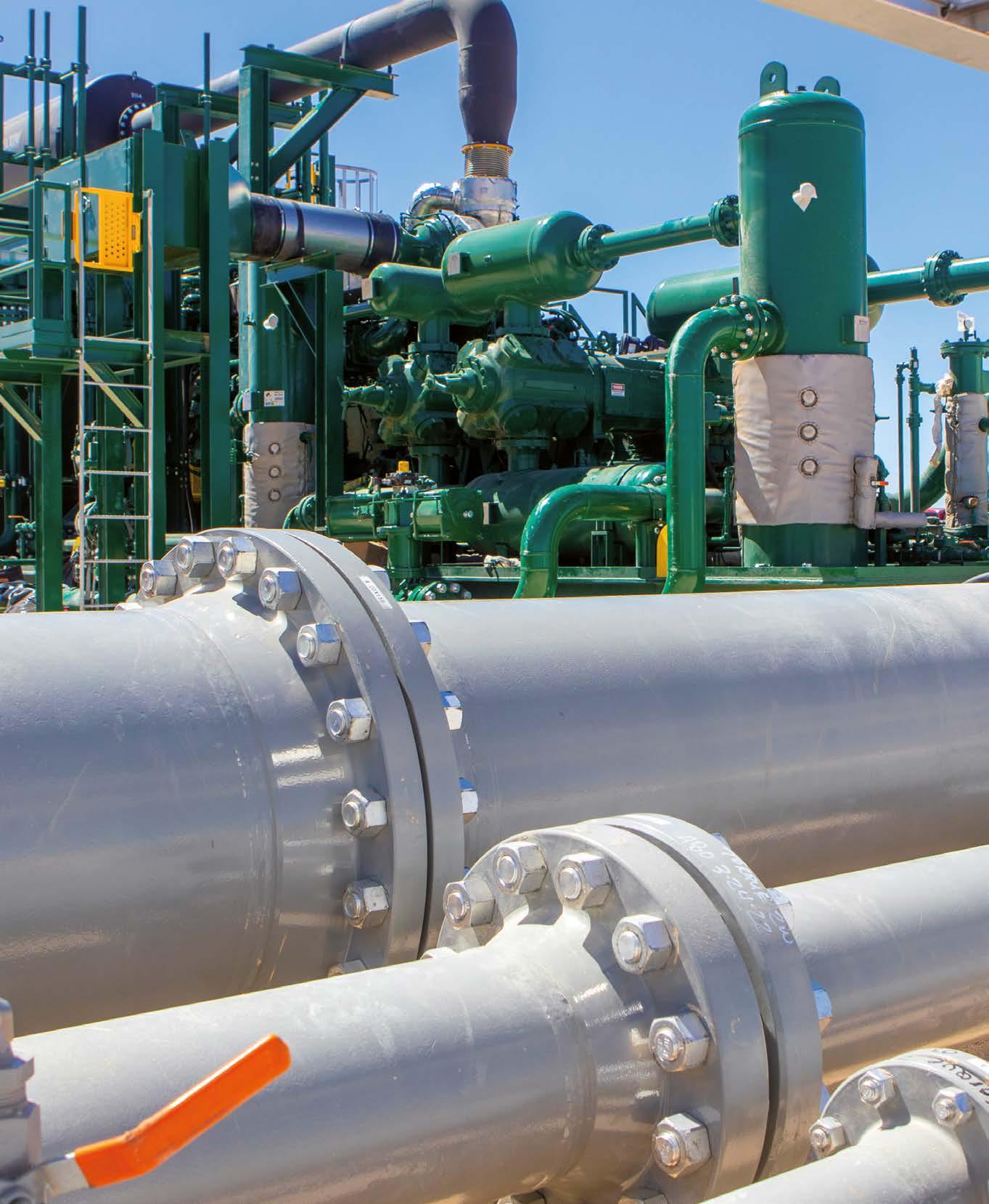
06 CORROSION PROTECTION | APRIL 2023
Achieve faster installation, less downtime with temporary coatings for flanges
by ANA JURAGA Cortec® Europe Advertising Agency, Zagreb – Croatia ana.juraga@ecocortec.hr
Piping is everywhere in process industries such as chemical and petroleum production. Furthermore, flange faces on the end of almost every pipe segment form a critical connection for pressure containment.

Any deterioration of these surfaces could diminish the integrity of that connection, making preservation imperative for safety and performance concerns.
Removable coatings are a great way to ensure faster installation and less downtime by keeping corrosion away from the flange face.
Removable coatings for flanges
Cortec® recommends two removable coatings for flange face protection. VpCI®-391 is a water-based temporary coating with low VOC (0.4 lbs/gal [48 g/L]). It leaves a clear non-tacky film that is virtually unnoticeable and can be easily removed with alkaline cleaners such as Cortec’s VpCI®-41x Series (which offers flash rust protection) before the pipe spool is installed. VpCI®-391 provides protection in harsh, outdoor, unsheltered applications
and has excellent UV resistance. Since the coating leaves a dry film, it is ideal for transit applications where pipes and flanges may be repeatedly handled. For the most extreme conditions, VpCI®-368 offers even heavier duty protection. This fast-drying solvent-based coating leaves a slightly brown waxy finish and should be removed prior to flange installation using an alkaline cleaner from the VpCI®-41x Series.
Removable coating advantages
As previously suggested, the main benefit of removable flange coatings is to avoid the ramifications of corrosion. Eric Uutala (Cortec® Technical Sales and Product Manager), who has extensive field experience with oil and gas industry preservation, explained the alternative: “If a raised face is damaged, either from corrosion or mechanical impact, it can cause significant delays in construction in startup activities. In the case of gramophone raised faces, the re-surfacing process can be very time consuming which could lead to further downtime (and money loss).”
07 APRIL 2023 | CORROSION PROTECTION ADVANCEMENTS
© Adobe Stock
ADVANCEMENTS
By taking the removable coating route, the protective mechanism conforms directly to the surface of the metal, not requiring an additional covering (e.g., plastic film) except what is needed for standard mechanical protection. In the case of VpCI®-391, there is minimal change to appearance—a plus for manufacturers concerned about aesthetics—and the coating is especially easy to remove for faster startup of the system.
Best practices for coating flange faces
Uutala reminds workers that flange preservation can be done at any point in the pipe life cycle—at the manufacturing plant, in the storage yard, or at the final site of operation. He outlines the flange coating process as follows:


make sure the flange face is clean and free of rust, dirt, coatings, and any other contaminants.
Apply either VpCI®-368 (for brown, waxy film) or VpCI®-391 (for clear, dry film) by brush.
Allow to dry for 1-2 hours (or more) before covering with rigid flange cover or other approved mechanical protection (avoid wood covers because they absorb moisture).
The bottom line
Ultimately, the condition of the flange face directly affects the condition of the system and is at risk at any point up to installation. Taking preventative measures to protect vulnerable flange faces from corrosion and mechanical damage during shipping and storage can go a long way toward preserving flange faces in their original state. A little time spent cleaning the flange and applying a coating now could translate into many hours and dollars saved later by avoiding resurfacing delays and minimizing system downtime. ‹
08 CORROSION PROTECTION | APRIL 2023
Removable coatings are a great way to ensure faster installation and less downtime by keeping corrosion away from the flange face.




ADVANCEMENTS
The hydropower industry and epoxy coatings
 by Alexander Ruiz Belzona – Miami Lakes (FL) – United States aruiz@belzona.com
by Alexander Ruiz Belzona – Miami Lakes (FL) – United States aruiz@belzona.com
10 CORROSION PROTECTION | APRIL 2023 SUCCESS STORY
© Adobe Stock
Hydropower is a renewable energy source that has been harnessed for thousands of years. Today, it is one of the most important sources of electricity in the world, and its use is only expected to grow in the future. One of the key components of the hydropower industry is the use of epoxy coatings, which are used to protect the machinery and infrastructure used in hydropower operations. In this blog post, we will explore the role that epoxy coatings play in the hydropower industry and the benefits they provide.
Epoxy coatings are a popular choice for use in the hydropower industry because of the many benefits they provide. One of the primary benefits of epoxy coatings is their ability to protect machinery and infrastructure from corrosion.
Corrosion is a major problem in hydropower operations because the equipment used is often exposed to water and other corrosive substances. Epoxy coatings provide a protective barrier that prevents corrosion from occurring, which helps to extend the life of the equipment and reduce maintenance costs.

11 APRIL 2023 | CORROSION PROTECTION
SUCCESS STORY
Another benefit of epoxy coatings in hydropower operations is their ability to provide a smooth surface for water to flow over. This is particularly important in turbines, where a smooth surface is essential for optimal operation. The use of epoxy coatings can help to reduce friction and improve the efficiency of the turbine, which can lead to increased power generation and lower operating costs.

Finally, epoxy coatings are also resistant to high temperatures and can withstand exposure to UV radiation. This makes them an ideal choice for use in the harsh environments found in hydropower operations, where machinery and infrastructure are often exposed to extreme temperatures and intense sunlight.

Hydropower industry case study
Belzona had the opportunity to improve the condition of a 60-year-old Kaplan hydropower unit that was showing signs of wear and was due for a full mechanical overhaul. Operators at the Hydropower Plant grit blasted and cleansed the unit with solvent. Belzona 1111 (Super Metal) was used to smooth over the wear and cavitation in a full skim coat. Once cured, the Belzona 1111 (Super Metal) was sanded down to the required profile, and frost blasted. Two full coats of Belzona 1341 (Super Metal Glide) were applied. The coating can provide increased efficiency on new and refurbished equipment while also providing full corrosion and erosion protection while immersed.
Surviving 60 years with minimal wear is impressive. However, by using Belzona 1341 (Super Metal Glide), the unit can continue to operate for many more years, providing reliable service and cost savings over the long term.
12 CORROSION PROTECTION | APRIL 2023 SUCCESS STORY
Hydropower unit during surface preparation for Belzona 1111 (Super Metal) application.
Hydropower unit assembled after Belzona 1111 (Super Metal) and Belzona 1341 (Super Metal Glide) application.
The coating can provide increased efficiency on new and refurbished equipment while also providing full corrosion and erosion protection while immersed.
The use of this product can improve the unit's resistance to wear and tear and can also provide an additional layer of protection against environmental factors such as moisture and chemicals.

The future of epoxy coatings in the hydropower industry
As the demand for renewable energy sources continues to grow, so too does the necessity for hydropower. This is expected to drive an increase in the use of epoxy coatings in the hydropower industry, as more and more equipment is needed to meet the growing demand for electricity. In addition, advances in epoxy coating technology are likely to make them even more effective at protecting machinery and infrastructure from corrosion and other forms of damage.
One area of particular interest is the development of epoxy coatings that are more environmentally friendly. As the world becomes increasingly concerned about the impact of industrial processes on the environment, there is a growing demand for
coatings that are engineered with plant-derived ingredients. The Belzona Research and Development Team are currently in the process of formulating products made from bio-based materials that are produced from sustainable plant-based feedstocks, rather than the traditional fossil-fuel based ingredients.
Conclusion
Epoxy coatings play a critical role in the hydropower industry, providing protection against corrosion, improving efficiency, and withstanding the harsh environments found in hydropower operations. As the demand for renewable energy continues to grow, the use of epoxy coatings in the hydropower industry is expected to increase, and advances in technology are likely to make them even more effective. By working together, the hydropower industry and coating manufacturers can help to develop coatings that are both effective and environmentally conscious, ensuring a sustainable future for the industry and for the planet. ‹
SUCCESS STORY
edited by MontiPower Hennef, Germany - info@montipower.com
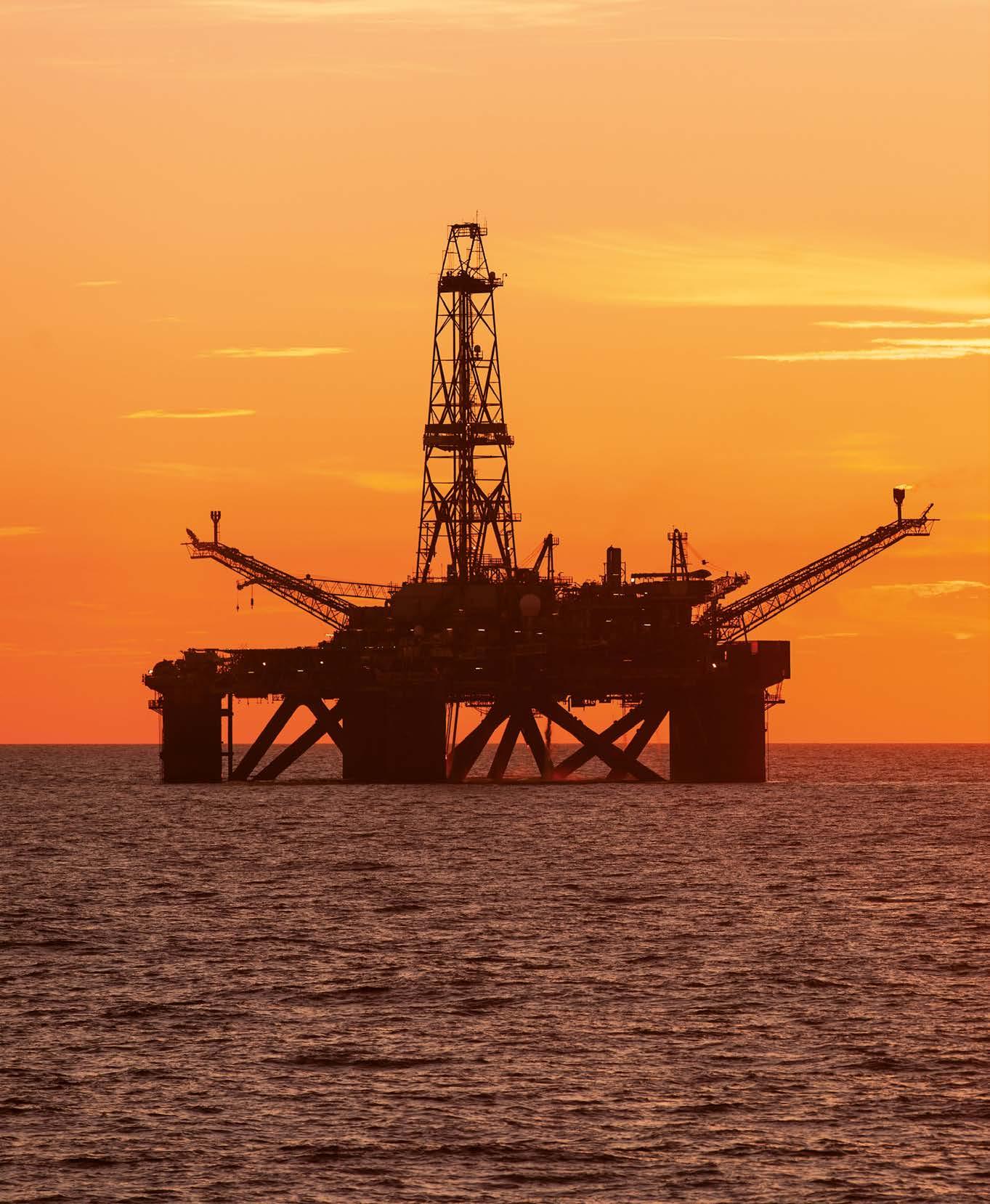
ADVANCEMENTS Bristle Blaster®: innovation in surface preparation
14 CORROSION PROTECTION | APRIL 2023 © Adobe Stock
The Bristle Blaster® is considered as a substitute for grit blasting and this is certainly true when it is used over small areas. However, it cannot be considered a substitute for grit blasting over larger areas where it cannot compete on production rates for OEM or outdoor work when access is possible.
Its main advantage for small areas is that no heavy equipment needs to be mobilized, there is little dust contamination produced in the work area and therefore the clean-up regimes are not as arduous. It is however much more advantageous than hand tools such as grinders and needle guns.
The benefits of the Bristle Blaster’s use are the following:
Corrosion, mill scale and coating removal similar to ISO 8501-1 Sa 2.5
Surface texture/anchor profile 40120μm Rz (1.6-4.7 mils)
Environmentally friendly / grit-free process
Improved surface integrity
Negligible heat generation
Simple and economical compared to grit blasting in the field.
Currently, when undertaking pipework paint preparation, corrosion removal and coating damage assessment work, the utility network services utilise grit blasting. This can be cumbersome, produces waste and required a two-person team to undertake safely. The use of the Bristle Blaster® for the above activities is cheaper, produces little waste and can achieve the same results as grit blasting for small surface areas.
The unit can be purchased in either 110v or pneumatic versions with the 110v version easily run from the team vehicle power source, or, coupled with the V2G mobile power supply, could allow for work in remote locations, without requirement for vehicle access.
Tests’ results for 3 different surface prep methods
A well-known European utility company did some research. Research was completed on coating adhesion and cyclic corrosion tests for three different surface prep methods used power wire brushing, grit blasting and bristle blasting. Power wire brushes can deliver SSPC SP 11 bare metal finishes, however, surface conditions ultimately lead to adhesion failure of the coatings due to poor anchor profiles. In contrast, bristle blasting removes coatings and affords an anchor pattern giving surface profiles similar to grit blasting. The difference between wire brushing and bristle blasting is that score markings & striations are eliminated, as bristle tips retract after impacting target surface. Corrosion tests were made under laboratory conditions after applying different coating systems on test specimens. Pull-off tests showed improved corrosion resistance for bristle blasting due to higher adhesion of coating systems. Surfaces machined by the power wire brushing were still corroded and therefore due to disbondment. That is, bristle blasting clearly outperformed power tool techniques, and is at least equivalent to and even can exceed the cleaning that is achieved by white metal blast cleaning SP 5 or ISO8501-1 Sa 2,5.
Health, safety & environment
Grit blasting process can produce hazardous dust and debris and must be performed by an individual that is confined or encapsulated in a control-suit, which both filters dust and supplies fresh air from a remote source. Furthermore, the noise level emitted by such equipment varies from 112-119 dB(A).
The equipment/apparatus used for carrying out grit blast operations is complex, costly, and requires considerable set-up and demobilisation time. Power wire brushing removes burrs and cleans impurities off various surfaces. The pipeline operator typically sees cup wire brush attachments utilised with angle grinders such as Makita GA4530. Cleaning and deburring with a wire brush remains by and large an intensely manual process, and produces a vibration magnitude of 7.5 m/s2. Choosing the right brush for the job and using the right technique can have a dramatic impact on throughput.
The grinders produce a Sound Pressure Level of 85 dB(A).
The wire bristle impact or bristle blasting process for surface preparation utilises a rotary disk which operates at a spindle speed of approximately 2,500 rpm. Noise levels emitted by this equipment are the same (83.5 dB(A)) for both the pneumatic and electric versions.
15 APRIL 2023 | CORROSION PROTECTION ADVANCEMENTS
After several years of development, the family of the Bristle Blaster ® tools has grown from strength to strength. These are devices characterized by ease of use, cost saving and reduced waste’s production, which guarantees the cleanliness and healthiness of the workplace.
The compact 2.3kg tool is operated by grasping both the control handle and the main body of the tool, and directly exerting the working surface of the tool against the surface to be prepared.
The user-applied force required for this operation are far below that required for grit blasting and power wire brushing operations. The electric tool produces a vibration magnitude of 3.1 m/s2, and can be used for up to five hours before the action level is reached.
The Bristle Blaster tools
The Bristle Blaster® has been developed and significantly enhanced over the years. Today, a wide range of Bristle Blaster® tools are available, including:
Bristle Blaster® Pneumatic, which has ATEX approval for use in Zone 2 as tested by Gexcon from Bergen with air-cooling.
Bristle Blaster® Electric Single, 110V and 240V units for standard electric power sources
Bristle Blaster® Cordless, electric
battery operated for use in remote locations and for rope-access work


Bristle Blaster® Double, 110V and 240V, fits 2 x 23mm Bristle Blaster belts for Double the bristle blasting area
Bristle Blaster® Axial – specially designed for difficult-to-reach areas such as weld seams, corners, flanges and more
Bristle Blaster® Subsea – for underwater surface preparation.
A Bristle Blaster® belt consists of spring steel wire bristle tips that are bent forward and dynamically tuned to the hand-held power tool. The bristle tips are specially designed and sharpened to strike the corroded surface with kinetic energy that is equivalent to conventional blasting processes that use grit blast media.
Immediately after the bristle tips strike the corroded steel surface, they retract from the substrate, which results in the removal of mill scale, rust, and existing paints and creates a new surface profile where the peaks and the valleys form a continuous
16 CORROSION PROTECTION | APRIL 2023 ADVANCEMENTS
Weld seam preparation and detection of the degree of roughness.
The surfaces that have been treated by bristle blasting have a texture and visual cleanliness that mimic those obtained by conventional grit blasting processes.
pattern with no smooth, unprofiled areas. Consequently, surfaces that have been treated by bristle blasting have a texture and visual cleanliness that mimic those obtained by conventional grit blasting processes.
The tools should be used with the accelerator bar when higher surface profiles depths are required or without the accelerator bar when lower surface profile depths are specified or for softer ferrous and non-ferrous substrates, including composites and aluminium. The Bristle Blaster® with the accelerator bar should regularly achieve surface profiles >75 micron (3 mil), while without the accelerator bar surface profiles of circa 25 micron (1 mil) is the norm.
Standard pneumatic and electric variomatic (also cordless) drive units without the accelerator bar are available as MBX®. MBX® stands for metal blasting and bristle blasting for steel substrates. The MBX® wire bristle tips are shorter than the Bristle Blaster® wires. The MBX carbon brush bristle tips are hardened. The MBX® bristles are available with a knee like the Bristle Blaster belts, but also without the knee as a straight variant for finer homogeneous surface profile grades. The MBX® comes in course, medium and fine variants similar to sanding machines.
The advantages of the bristle blasting processes




Bristle blasting simplifies the surface preparation operation and reduces costs through the elimination of expensive equipment, media and extensive environmental and safety measures. Although the bristle blasting process is ideally suited for spot repair applications, it can also be readily applied to larger surface areas where the use of other metal cleaning processes may be prohibitive.
For any coating job, it is recommended to make an assessment of the correct tool and bristle for the surface desired and the application at hand. This is particularly true for difficult to prepare areas such as corners, edges, and weld seams. For flat surfaces, the Bristle Blaster® Double or Prepper® Quattro can bring significant efficiency gains in terms of time and costs. An assessment of the operating area will also need to be considered, though the Bristle Blaster® or MBX® is specially designed for a wide range of environments:
Bristle blasting does not use or produce hazardous materials
– steel bridges can be bristle blasted safely while passenger trains continue to operate
Bristle blasting is a green alternative with low vibration levels and sound pressure – pipelines in environmentally protected areas can be safely prepared with the Bristle Blaster and the consumed belts can be recycled
Bristle blasting is a cost-efficient alternative – set-up is
Waterborne Solventborne High solid INDUSTRIAL COATINGS Mirodur S.p.A. Via delle Scienze, 3 - 04011 Aprilia (LT) Tel. +39 06 9281746 Fax +39 06 9280644 www.mirodur.com - info@mirodur.com


18 CORROSION PROTECTION | APRIL 2023 ADVANCEMENTS
Surface Profile Measurement by Keyence in 3D.
Keyence 3D results of epoxy coated panel treated by the Bristle Blaster.
quick and easy and there is no need for enclosures, grit-recovery, breathing apparatus or complex equipment
Bristle blasters are extremely portable and extremely lightweight – weighing as little as 1.1kg and vacuum control units (also cordless) can be easily connected
New features are always being introduced – such as dead man’s switch, safety caps, and rope access fittings – continually making bristle blasters even safer and more convenient on the job.
Bristles are available in carbon steel and stainless steel, with belts available in a range of sizes from 43mm, 23mm, 11mm and half 11mm bristles. Zapper wheels in silicone at 1300RPM as cordless units or yellow wheel erasers (up to 3500RPM) are also available for edge feathering of thick polyethylene, polypropylene or removal of glue and glued foils/stickers.
Monti surface preparation equipment is also available for use with drones, magnetic wall crawlers or walk-behind solutions, ideal for decks and floors.
For best use of the tool(s), it is highly recommended that the user is trained by qualified individuals. Understanding the proper technique and approaches to different applications are important for best results and in ensuring efficient use of the tools and belts to ensure the best possible coating and sealant bond.
Advantages of the bristle blasting method:
No special skills required (training recommended for best use)
Minimal safety and hazmat requirements when compared to abrasive blasting
Much smaller environmental footprint when compared to abrasive blasting
Cleanliness grades similar to ISO 8501-1 Sa2.5 /SSPC-VIS1 SP 10/Nace No.2
Complimentary to abrasive blast cleaning for critical areas such as weld seams and hard to reach areas.
Low noise, low vibration and low rotational speeds of approximately 2500 RPM
Versatile with different tool configurations and different sized belts for different applications

Efficient surface profiling solutions in combination with other methods such as induction coating removal or water jetting
Bristles can be resharpened for longer use, and bristles can be recycled
Removes mill scale
Bristle Blaster Axial drive units are specially designed for difficult to reach areas
Bristle Blaster Pneumatic units are ATEX approved for surface preparation in potentially explosive environments
No burnishing, polishing or smearing effect.
Disadvantages of the bristle blasting method:
Less efficient at removing thick-pack rust
Less efficient than abrasive blast cleaning for large surfaces
Bristles can create cold sparks with metal contact.
Whether removing, cleaning or profiling, the Bristle Blaster is a powerful technology ideally suited to a wide range of fabricating and infrastructure-support operations such as onshore/offshore well drilling installations, bridge refurbishment, the fabrication and repair of naval / marine vessels and industrial maintenance applications. ‹

19 APRIL 2023 | CORROSION PROTECTION ADVANCEMENTS
The Bristle Blaster® developed by MontiPower and an operator preparing a pipeline’s surface.
HIGH CORROSION PROTECTION, EXCELLENT EDGE
COVERAGE: FREILACKE DEVELOPS A NEW POLYESTER SYSTEM BASED ON PRIMID
by Oliver Zanner
Emil Frei GmbH & Co. KG - Bräunlingen-Döggingen, Germany o.zanner@freilacke.de
Many ingredients such as TMA or BPA (bisphenol-A) have been criticised in recent years because classified as hazardous.
FreiLacke developed new, non-declarable polyester coating systems with the FREIOTHERM powder coating PS3005 and PP3005 series, particularly suitable for industrial applications and for construction and agricultural machinery.
‘Primid’ is the trade name of a hardener that belongs to the chemical class of β-hydroxyalkylamides and shows its strengths especially in the cross-linking of powder coatings. In addition to very good corrosion protection, the material offers high weather resistance and excellent colour stability. The use of Primid hardener and its toxicologically favourable profile means FreiLacke’s new polyester system does not require labelling: It is completely free of problematic components. Compared to epoxy resins, the production of polyester coatings requires significantly less energy.

ADVANCEMENTS
20 CORROSION PROTECTION | APRIL 2023 © Adobe Stock
Environmental protection is therefore already considered in the formulation of this system. Aside from that, epoxy resins are mainly produced outside Europe whereas the new polyester system makes costly transport by sea unnecessary. Finally, coaters thereby circumvent the well-known price volatility of epoxy resins, which continues to fluctuate strongly. One minor drawback: so far, the new coating system can only be used under standard baking conditions (10 minutes at 180 °C object temperature). A variant for low-temperature applications (10 minutes at 160 °C) for high-quality pre-treatments is already in progress. The newly developed polyester-based powder coating was designed with the focus on excellent corrosion protection properties.
FREIOTHERM powder coatings based on PS3005 and PP3005 can be used as single-layer or two-layer coatings. “The new twolayer coating system provides corrosion protection that almost reaches the level of a classic epoxy primer,” explains Alexander Schelling, who is responsible for powder coating development at FreiLacke.
“The advantage for the coater is that there is no need for a separate primer and the topcoat is simply applied twice.” When using a topcoat with high pigmentation costs, however, it is still advisable to use a separate primer.
The FREIOTHERM powder coatings PS3005 and PP3005 are available on request in all surface finishes – smooth, fine and coarse structured – as well as in gloss levels from high gloss to silk gloss.

Forward-looking development
In addition to excellent corrosion protection, the new system also offers very good edge coverage, which virtually eliminates rust damage. “If edges and laser cuts are sufficiently rounded, the polyester coating can also be used in a single layer and, compared to classic industrial/facade powder coatings, brings a clearly noticeable added value in terms of corrosion resistance,” emphasises Jakob Zihsler from FreiLacke’s powder coating development department.

The PS3005 was developed in response to a specific customer request from the agricultural and construction machinery sector. FreiLacke took this as an opportunity to revise the existing corrosion-optimised systems as a whole. “The development took about two years. We started the development proactively because we knew this was coming,” explains Zihsler. The above systems can also be modified according to customer-specific requirements. In the meantime, more than ten reference customers are already using the new systems in a wide variety of modifications. ‹

21 APRIL 2023 | CORROSION PROTECTION ADVANCEMENTS
FREIOTHERM PP3005/PS3005 Epoxy Hybrid Corrosion protection + ++ o Edge coverage ++ ++ + UV stability + / ++ - o Flexibility + + ++ Gas furnace resistance ++ O + Resistance to yellowing ++ O + FREIOTHERM PP3005/PS3005B Industrial polyester Facade polyester Corrosion protection ++ o + Edge coverage ++ + o UV resistance + o ++ Flexibility + + ++
The properties of the new polyester coating compared to epoxy and water-borne coatings.
FREIOTHERM PP3005/PS5205 compared to conventional polyester powder coatings.
Edge unfinished, two-layer.
Edge rounded, single layer.
Edge rounded, two-layer.
RESEARCH BREAKTHROUGH

22 CORROSION PROTECTION | APRIL 2023
© Adobe Stock
Reducing operation and maintenance costs of offshore wind turbines
copyright European Union, 1994-2023
Researchers have developed a high-accuracy, real-time, unattended, fast-response solution based on ultrasounds to monitor corrosion – an issue facing offshore structures.
Offshore wind is a fast-growing renewable energy source. In 2021, installed offshore wind capacity was 14.6 GW1 in the EU, a number set to increase by at least 25 times in 2030. Its deployment, therefore, plays a key role in achieving the European Union’s long-term climate and energy objectives2. However, the operation and maintenance (O&M) of offshore wind turbines is a challenging

1 https://energy.ec.europa.eu/topics/renewable-energy/offshore-renewable-energy_ en#:~:text=The%20installed%20offshore%20wind%20capacity,the%205%20EU%20sea%20basins 2 https://cordis.europa.eu/programme/id/H2020-EU.3.3
and costly process. This is a result of environmental conditions that cause high levels of corrosion and the lack of easy access to these turbines. “Addressing this, the EU-funded WATEREYE3 project set out to reduce O&M costs by designing an integrated solution that will enable wind farm operators to accurately predict future maintenance needs in real time in an unattended manner,” notes Ainhoa Cortés, project coordinator.
3 https://watereye-project.eu/about/
23 APRIL 2023 | CORROSION
PROTECTION
A closer look at the WATEREYE monitoring system

“We aimed to design a smart corrosion monitoring system to cover two fundamental areas: the splash zone and the atmospheric zone of an offshore wind turbine,” explains Cortés. The idea of the system is to monitor primarily the corrosion of the outer side of the wind turbine structure from the inner surface. “To cover large structures, a mobile platform based on a drone was proposed. This way, a smart ultrasound system is embedded into the drone allowing for the measurement of a high number of critical points per year,” adds Cortés. The splash zone, however, is different because this is a restricted area that is impossible to access with a drone. To monitor it, the project used a matrix of smart sensors that were fixed to measure the most critical points. “This way, the WATEREYE solution measures the wall thickness and relates the loss of thickness with the corrosion level,” confirms Cortés. The ultrasound data is sent wirelessly to the base station located inside the wind turbine. “We developed the algorithms, models and software tools to process the acquired data for a range of tasks,” adds Cortés.

24 CORROSION PROTECTION | APRIL 2023
© WATEREYE
The PLOCAN oceanic platform of the Canary Islands and the WATEREYE monitoring system.
WATEREYE is a smart corrosion monitoring system designed to cover two fundamental areas: the splash zone and the atmospheric zone of an offshore wind turbine.
Overcoming current limitations of operation and maintenance efficiency

The WATEREYE solution was tested in a real environment at the offshore platform of PLOCAN4, where its functionality was successfully validated. “Mainly, the physical system: ultrasound measures and corrosion detection, drone positioning and wireless communications,” reports Cortés. Project results showed that the monitoring solution can detect the corrosion of large structures with high accuracy through a low-cost, low-weight and low-power consumption monitoring system. “We have designed a highaccuracy, unattended, fast-response and non-invasive ultrasound smart sensor and characterised the monitoring system to be flexible enough regarding the type of corrosion and the target thickness,” outlines Cortés.
The project has also successfully enhanced the calibration methods and communications protocols of the radio frequency technologies with the aim of transmitting the measures wirelessly
4 https://plocan.eu/en



with high reliability inside a metallic offshore tower. “We have also achieved a precise positioning of the drone inside the wind turbine and developed mathematical models to detect the corrosion degradation rate and predict the type of degradation and failure mechanisms that a given coating/steel material combination will suffer from, in a given environment,” confirms Cortés. As for the next step, “it would be to analyse in depth pitting corrosion, and the idea is to enhance the developed ultrasound solution to quantify the pit size,” concludes Cortés. ‹
Cavitation
Erosion
Corrosion
Engineering made in Germany - since 1960
Ultra wear resistant elastomeric coatings repair compounds

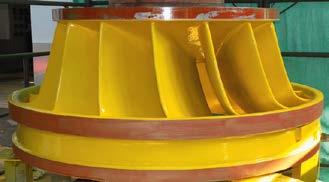
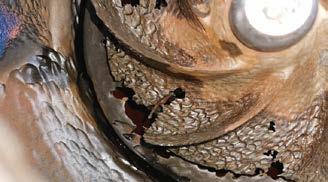
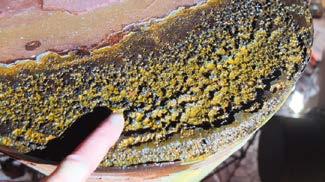
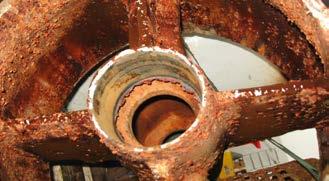




RESEARCH BREAKTHROUGH Extends the service life of steel by up to 500 %
„I would love to have your problems !!!“
Scan or click the QR Code to learn more about the WATEREYE project
ROAD TO 2050
PPG SIGMAGLIDE 2390 marine coating delivers dramatic power savings and emissions reductions
PPG developed a new technology which is able to modify the coating when it is immersed in water to create a super-smooth, almost friction-free surface that marine organisms do not recognize and cannot adhere to.

26 CORROSION PROTECTION | APRIL 2023
PPG announced the launch of PPG SIGMAGLIDE® 2390 marine coating, a breakthrough approach to help shipowners lower power consumption and carbon emissions and meet demands for higher performance with no adverse impact on the marine environment. The biocidefree fouling release coating is based on revolutionary PPG HYDRORESET™ technology, which modifies the coating when it is immersed in water to create a super-smooth, almost friction-free surface that marine organisms do not recognize and cannot adhere to. Based on third-party evidence following ISO 19030 and ITTC* standards, this coating enables vessels to maintain a clean hull and reduce drag, achieving power savings of up to 20%, a speed loss performance of less than 1%, and up to 35% reduction in CO2 emissions in comparison to traditional antifouling coatings. Actual performance will depend on ship model and operating conditions.
PPG Sigmaglide 2390 coating can help owners and operators to meet targets for reduction of greenhouse gas emissions under the International Maritime Organization’s energy efficiency (EEXI
and EEDI) and carbon intensity (CII) requirements, which went into effect this year.
“PPG Sigmaglide 2390 coating is a unique formulation that paves the way for ship owners and operators to improve efficiency and reduce CO2 emissions,” said Jan Willem Tegelaar, PPG global platform director, Marine Coatings. “The speed loss performance of less than 1% helps ships operate at an average one knot higher speed while remaining CII compliant.”
The exceptional fouling control performance of PPG Sigmaglide 2390 coating is achieved with no release of biocides into the oceans.
PPG Sigmaglide 2390 coating is also suitable for electrostatic application, which provides high transfer efficiency, leading to lower paint consumption. In service, the coating can deliver up to 150 days of idle performance and an extended lifetime of more than 10 years with minimal maintenance requirements. These benefits, combined with the power savings, provide an industryleading return on investment for shipowners. ‹

27 APRIL 2023 | CORROSION PROTECTION ROAD TO 2050
Micro-cracks caused by corrosion under insulation in France’s nuclear power plants
by Monica Fumagalli, ipcm®
The electricity supply of France, the world’s fifth-largest economic power, is being severely challenged by corrosion damage in the pipes of the primary and auxiliary cooling circuits of numerous nuclear reactors.

THE BREAKDOWN
© Adobe Stock 28 CORROSION PROTECTION | APRIL 2023
Anow famous report released a few years ago by NACE International1 estimated that the global cost of corrosion is equivalent to over 3% of world GDP. As is easy to deduce, maintenance and repair of damage caused by this relentless phenomenon have always played a major role in the management of assets, as it can have major economic consequences and even lead to emergency situations in terms of energy resources, such as, for example, the interruption of electricity and gas supply.
In addition to this, when it comes to nuclear energy, one of the most serious effects can be a leak in pipes, with a high risk of radioactive substances escaping. For more than a year now, this issue has been particularly topical in France, as periodic inspections have revealed micro-cracks in the primary and auxiliary cooling circuit piping of some reactors caused by corrosion under insulation, which has led to the closure of the affected power plants for repairs with well-known repercussions on the French government’s energy policy.
The current situation
In February, EDF - Électricité de France S.A., France’s leading energy producer and distributor, released some data on its electricity production in 2022, including almost 18 billion of Euros
The resulting interruptions meant that last year France became a net importer of electricity for the first time in decades. Now, what is causing the French nuclear power plants’ corrosion problems?
The origin of these problems
Caused by moisture accumulating under thermal insulation, corrosion under insulation can sometimes take the form of stress corrosion. This occurs due to the combined action of corrosion and prolonged tensile stress that causes the sudden and unexpected fracture of metallic materials and is characterised by rapid propagation due to these two factors’ interaction. At the end of 2021, stress corrosion cracking was discovered affecting the primary circuits of some of EDF’s nuclear reactors, which led to their prolonged shutdown for necessary repairs. Inspections carried out on nuclear reactors showed that almost one third of the French nuclear fleet was affected by corrosion issues and, as one of France’s best-known business and financial newspapers pointed out, by May 2022 the situation was so dramatic that not a week went by without “corrosion sous contrainte” being mentioned in media reports3
Inside a reactor
Nuclear power plants produce electricity using the heat generated

THE BREAKDOWN
29 APRIL 2023 | CORROSION PROTECTION
This cycle takes place in the so-called “primary circuit”. This, however, is not a completely closed loop: emergency circuits are connected to it for safety. In an emergency, this system allows water to be sent from a tank to cool the reactor. At the same time, since neutrons, uranium, and fission products are radioactive and therefore potentially harmful to living beings, the reactor is enclosed in steel and lead tanks to shield radiation and then protected with a double concrete casing.
Sixteen reactors, one common defect
The inspections carried out by EDF found that most of the micro-cracks caused by stress corrosion were located on the steel pipes (with a diameter of 25 to 30 cm and a thickness of 3 cm) that make up the “auxiliary circuits” connected to the reactors’ primary circuit, in which water circulates at around 330 °C. At the end of 2021, anomalies were found very close to their connection with the primary circuit, at a point where the pipes form a curve. Micro-cracks up to 5 mm caused by stress corrosion were found along the welds of these angle pipes. Since the thickness of steel pipes is 3 cm, there was no risk of leakage, but it was still necessary to take action to prevent these cracks from widening. Experts agreed that the problem stemmed from the shape of the angle pipes themselves, which can generate enough temperature changes to put a strain on steel. This defect concerns all the 16 most recently-built reactors. Repairing them is possible, but it is necessary to stop each reactor, replace the damaged part of the pipework, and reweld it, obviously while paying the utmost attention to radioactivity.
First signs of corrosion: the Civaux nuclear power plant
According to an official statement by EDF4, on 15 December 2021, during the second ten-year inspection carried out with nondestructive methods on reactor No. 1 in Civaux (New Aquitaine), one of the newest ones in the French nuclear fleet, damage was found in the stainless steel of a part of the piping of the safety injection system (the so-called “RIS”).
Ultrasonic tests on this circuit revealed faults at two welds located upstream and downstream of one bend of the 4 lines constituting the safety injection circuit. No defects had been found during the first inspection in 2011. EDF therefore proceeded to section the affected parts of the pipeline. Laboratory tests confirmed that the defects observed on the Civaux 1 reactor were linked to a degradation phenomenon that simultaneously involves the material and its intrinsic characteristics, i.e. the mechanical stresses to which it is subjected and the nature of the fluid circulating in it.
4 https://www.edf.fr/sites/groupe/files/contrib/groupe-edf/ producteur-industriel/carte-des-implantations/centrale-chooz/ actualites/2022/JANVIER/edf_note_info_ris_14janv2022.pdf

30 CORROSION PROTECTION | APRIL 2023 THE BREAKDOWN
The inside of a nuclear power plant: you can notice the several angle pipes.
Ultrasonic tests on the reactor No. 1 in Civaux revealed faults at two welds located upstream and downstream of one bend of the 4 lines constituting the safety injection circuit.
This is known as “corrosion under insulation” and it can be detected by carrying out specific ultrasonic tests, such as those carried out preemptively by EDF during inspections of its reactors. Other checks were then carried out on the same structures at reactor No. 2 of the Civaux nuclear power plant and they revealed similar anomalies.
The 4 reactors of the Civaux and Chooz (Ardennes) power plants use the same technology and form the N4 series of the French nuclear fleet. Therefore, as a precautionary measure, EDF decided to shut down the 2 reactors at the Chooz power plant in order to carry out these same checks. In the course of these inspections, a fault was detected on a section of the pipework in reactor No. 2 at Chooz B. Assessments are going to be extended to other areas. EDF concluded its report by stating that “solutions are being assessed for the replacement or repair of the affected portions of the pipeline. They will be implemented on a case-by-case basis, depending on the results of the inspections, in order to ensure the safety of all facilities,” and by communicating the duration of service interruptions due to repair work. Since these initial findings, other similar faults have been found in further reactors of the French nuclear fleet. The most recent one was at the Penly plant (Seine-Maritime), which was due to come back on line in May.
The last inspection: the Penly nuclear power plant
On 24 February this year, EDF announced that checks were being carried out on the welds of a pipe of the Penly 1 reactor, which had been repaired in January. This inspection quickly led to the discovery of a very large crack. According to the “Transitions & Energies” magazine5, the discovery of this further defect shows that the maintenance problems of the 56 reactors of the French
5 https://www.transitionsenergies.com/reacteurs-nucleaires-francais-pas-seulement-affectes-parcorrosion-sous-contrainte/
nuclear fleet go far beyond the stress corrosion issues detected in 2021, probably caused by a design flaw in the most recent reactors, which in turn leads to physical stresses on the materials causing cracks. In Penly, early indications are that the weak point would be some welds on the emergency cooling circuit that were “repaired” or “touched up” during the construction of the plant. A note released by the French Nuclear Safety Authority (ASN)6 stated that this significant corrosion defect consisted of a large crack with a length of 155 mm, i.e. one quarter of the pipe’s circumference, and a maximum depth of 23 mm, compared to a total pipe thickness of 27 mm. This resulted in the closure of the power plant for the necessary repairs and in the decision to change all the affected circuits at the same level as Penly (N4) and its predecessor, the 1,300-MW P’4-series reactor, by the end of 2023.

Conclusions
EDF pointed out that the occurrence of stress corrosion cracking is related to several factors – above all, the auxiliary circuit lines’ geometry and, secondly, the state of the welds and the mechanical stresses that this generates on the material. We can therefore conclude that, while it is true that the preparation of substrates, the choice of the most appropriate corrosion protection coatings, and the correct inspections are key to prevent corrosion, the ability to take into account already during the design phase the consequences that a given structure may have on the system’s circuits, including the stagnation of humidity that weakens the material and the mechanical stresses to which the entire system is subjected, is also essential to guarantee proper functioning and avoid service interruptions with serious consequences for an entire community and the economy of a country. ‹
THE BREAKDOWN
Proven long lasting steel protection enabling the future of energy jotun.com/baltoflake
Master the forces of nature
6 https://www.asn.fr/l-asn-informe/actualites/corrosion-sous-contrainte-a-penly-niveau-2-sur-lechelle-ines

Zentek introduces a novel corrosion protection technology: ZenARMOR™ Edited by ZENTEK LTD Guelph (Ontario), Canada info@zentek.com ADVANCEMENTS 32 CORROSION PROTECTION | APRIL 2023 © Adobe Stock
Corrosion is a costly issue that significantly impacts naval and marine infrastructure, bridges, buildings, pipelines, and many other industries. To help combat this problem, corrosion protective coatings can extend the life of existing infrastructure and equipment.
“The economic cost of corrosion is significant. According to a United States Congressional Briefing on May 31, 2012, corrosionrelated costs amounted to US$452 billion per year in the US, including US $22 billion for the Department of Defense. The global anti-corrosion coating market was estimated to be $27.4 Billion in 2019 and expected to grow to 63.7 Billion by 2030 according to Business Wire.” said Greg Fenton, CEO of Zentek. “To help address this issue, corrosion protective coatings are used to extend the life of existing infrastructure and equipment, generally providing a high return on investment. With ZenARMOR™, our team has developed a nanomaterial-based technology that has the potential to further enhance this return on investment by not only improving the performance of existing corrosion protection solutions but doing so in a way that reduces environmental impact.”
Third-party testing
The company is collaborating with Quantum Chemical, a division of Quantum Technical Services Ltd., a manufacturer of highperformance primers and coatings. Testing by Quantum Chemical of ZenARMOR™ in an epoxy system following ASTM B-117 Salt Spray Testing demonstrated excellent corrosion resistance with no blisters or any other signs of corrosion after 1,500 hours with the addition of a very low dose of ZenARMOR™ versus the same corrosion protection epoxy without ZenARMOR™ which started breaking down at the 1000-hour mark. ZenARMOR™ is also comprised of fewer active ingredients compared to other products in the market, which management
believes potentially has environmental benefits versus other corrosion protection products. Testing is ongoing and the company will report on further significant testing milestones. Tony Lagrange, founder, and owner of Quantum Chemical since 1995 commented: “these initial results of ZenARMOR™ after 1,500 hours of salt spray testing is impressive. Corrosion is a significant problem, and we are excited to be part of the Zentek testing and optimizing strategy for the ISC challenge and to help address this global corrosion problem. We are also leaders in the development of intumescent coating and paint products. We have significant inhouse testing infrastructure equipment for intumescent coatings optimization. We are well positioned to work with Zentek on both corrosion and intumescent coating technologies that can improve performance and safety while reducing environmental impact.”
Next step: innovative solutions Canada testing stream – Military call for prototypes
The company also reports that a proposal for its ZenARMOR™ corrosion protection self-healing coating was submitted to the Innovative Solutions Canada (ISC) testing stream – Military Call for Prototypes. The company is pleased to announce that it has been advised that the ZenARMOR™ proposal has met the mandatory and technical evaluation criteria of the Military Call for Prototypes, Military Component, and is considered conditionally qualified, pending further steps such as matching our innovation with a Government of Canada Organization (GCO) interested in testing ZenARMOR™. The company and the ISC program have begun to socialize ZenARMOR™ to GCOs, exploring opportunities for partnership and testing. Conditionally qualified innovations are now listed on the ISC website.
Intellectual property
The company has filed a provisional patent with the United States Patent and Trademark Office for the ZenARMOR™ corrosion protection technology and has also filed a trademark for ZenARMOR™.
About Zentek Ltd.
Zentek is an IP development and commercialization company focused on the research, development and commercialization of novel products using graphene and nanomaterials for use in the healthcare industry and beyond.
Zentek’s patented ZenGUARD™ coating is shown to have 99% antimicrobial activity and to significantly increase the bacterial and viral filtration efficiency of both surgical masks and HVAC systems. Zentek’s ZenGUARD™ production facility is located in Guelph, Ontario. ‹
33 APRIL 2023 | CORROSION PROTECTION ADVANCEMENTS
Zentek Ltd, an intellectual property development and commercialization company, has developed ZenARMOR™, a novel corrosion protection technology based on functionalized Graphene Oxide (GO) that offers superior performance, self-healing properties and a potential environmental advantage.
A tale of the sea
by Marco Cattalini
AMPP Italy Chapter Chairman and Technical Manager at CorE srl marco.cattalini@coreconsultancy.it
A note on subsea pipelines cathodic protection design

At the end of September 2022, some devices, planted and detonated probably with the help of subsea drones, damaged and made inoperable the two lines of the North Stream Pipeline. An act of sabotage whose perpetrators will probably remain forever unknown in this difficult historical period marked by pandemic, war, and energy crisis. The construction of that undersea pipeline had been the result of a technical and engineering effort in which Italy had been at the forefront both on the design and engineering side with the extraordinary work of Snamprogetti and on the construction side with the commitment and operational capabilities of Saipem; a work of which we should have been justly proud.
Two 1200 km long 48” diameter lines
laid on the bottom of the Baltic Sea. A cyclopean project with a focus on environmental impact that had united distant countries in the name of common and mutual interests. Those pipelines are now out of service, even though they had actually been designed to last with an estimated operational life longer than half a century and, as is always the case with this type of infrastructure, their integrity against corrosion had been entrusted to the combined action of coatings and cathodic protection. In this page, I would like to analyze the approach to a typical design of a submarine cathodic protection systems, may be only as a nostalgic tribute to those pipelines destroyed with explosive charges that, many years ago, were the subject of one of the most important projects that I personally had the possibility to work at.
34 CORROSION PROTECTION | APRIL 2023 SCIENCE OUTLOOK
© Adobe Stock


SCIENCE OUTLOOK © Adobe Stock
Like a compass on the high seas
Sailing on the sea of cathodic protection engineering we will find a compass in international standards and regulations. When approaching the design of a cathodic protection system for a subsea pipeline, it will be necessary to take into account, both as a general design philosophy and in relation to the choice of calculation method, specific regulatory and technical references that guide the process.
Subsea pipelines are managed by large companies in the Oil & Gas sector (ENI, TOTAL, EXXON...) or by consortia created specifically for the project itself and, often, companies of this size have an internal regulatory system that regulates the design and management of their assets. It is therefore necessary to refer to corporate specifications. In other cases, however, the project will be subject to the relevant international standards such as: ISO
15589-2: “Petroleum, petrochemical and natural gas industries
- Cathodic protection of pipeline transportation systems - Part 2: Offshore pipelines” or DNV-RP-F103 “Cathodic protection of submarine pipelines Recommended practice.”
Organizing our galley
In order to finalize the cathodic protection design, it will be necessary to collect a complete set of input data that will allow us to evaluate in details a correct protection current requirement and the best way to achieve it.
To do this we will need to find or assume several different parameters related to different aspects of our design such as:
Environment
Pipeline physical and geometrical characteristics
Laying criteria
Operating conditions.
Starting from environmental characteristics we have to include in our input data salinity and more directly the electrical resistivity of seawater and sediment in the laying area.
Average water temperatures at the laying depth and at sea surface, affect both the delivery capacity of sacrificial anodes by directly modifying their resistance, and the aggressiveness of the electrolyte, which could instead affect the amount of current needed for line protection.

36 CORROSION PROTECTION | APRIL 2023
SCIENCE OUTLOOK
Average water temperatures at the laying depth and at sea surface, affect both the delivery capacity of sacrificial anodes by directly modifying their resistance, and the aggressiveness of the electrolyte, which could instead affect the amount of current needed for line protection.
Laying depth, on the other hand, directly affects the concentration of dissolved oxygen in the seawater and consequently the current required for line protection.
The chemical composition and the presence of specific substances in the water layers at the laying depth also influence the design: areas with particularly low salinities due to freshwater layers related to thawing periods or the presence of H2S in higher or lower concentrations as in the Baltic Sea or the Black Sea may limit the use of certain anode alloys as imposing more stringent protection criteria. Total length of the lines and their diameter are essential starting data for any design.
The geometry of the pipeline is not only essential for the correct calculation of the surfaces to be protected, but also dictates the conditions governing the sizing of the galvanic anodes. Apart from shorter pipelines and shore approach sections, in almost all cases, protection is in fact realized by means of sacrificial systems. These are normally based on so-called “bracelet” anodes consisting of two shells that are installed astride the line itself and then electrically connected by cables or steel straps welding. The size of the anodes cannot therefore be separated from the dimensions of the pipeline, which become binding for their design and construction.
The characteristics of the pipeline also include the technical details related to the anticorrosive coating that directly contributes to the assessment of the protection current and the possible concrete coating layer, used both as a weighting of the line to increase its stability on the seabed and as mechanical protection, that can introduce limits to the maximum thickness of the galvanic anodes.
Although most pipelines are made of carbon steel, it is sometimes possible to have to make protection systems for other materials such as stainless steels with significant impacts on the choice of protection criteria, the composition of the anode alloy of

the sacrificial anodes, and the presence or absence of special control and current-limiting systems inserted into the electrical connections.The laying of subsea pipelines requires special conditions that often have direct impacts on the design and operation of cathodic protection systems. First, the individual pipe joints, which have a standard length of about 12 m, must be welded together inside the pipe-laying vessel and then lowered into the sea through a complex system of rollers and track tensioners that ensure their stability. The need for the pipelines to pass through rollers and tensioners significantly conditions the maximum thickness and shape of the bracelet anodes installed on the pipeline since these shall not only not be an obstacle to laying operations, but also be installed in such a way they will withstand the impacts and mechanical stresses due to the passage of the line over the transport and control systems.


Geological information on seabed conditions will then be necessary to predict, already at the design stage, what the condition of the pipeline’s burial will be once it has touched the seabed. In fact, it will be necessary to consider whether it is resting on the seabed itself or sunk into the marine sediment; as a matter of fact, the pipeline’s burial conditions will impact the delivery capacity of the anodes as much as the line’s current demand. In particular situations related to stability problems due to particular underwater currents or to the need to provide mechanical protection to the pipelines in fishing areas or in correspondence with underwater crossings with other lines, it may be necessary to proceed with a forced burial of the pipelines through the excavation of underwater trenches or with the technique of “rock dumping,” i.e., covering the line laid on the seabed with rocky material.
Another fundamental information for the cathodic protection system sizing is the temperature of the line. Indeed, this affects both the amount of current required to protect the surface of
37 APRIL 2023 | CORROSION PROTECTION SCIENCE OUTLOOK
From left to right: The geometry of the pipeline is not only essential for the correct calculation of the surfaces to be protected, but also dictates the conditions governing the sizing of the galvanic anodes; the laying of subsea pipelines requires special conditions that often have direct impacts on the design and operation of cathodic protection systems.
the line itself and the electrochemical efficiency of the anodes; in fact, the amount of protection current expressed by a given mass of anode alloy is directly related to its operating temperature. At the expense of the anodic reaction underlying the protection process, the electrochemical self-corrosion reactions triggered in the sacrificial alloy become increasingly competitive as the temperature rises. As a consequence, the mass of sacrificial anodes required to protect the pipeline for the expected lifetime increases significantly in relation to the temperature of the section.
It therefore becomes necessary to collect data from a detailed thermal analysis of the line carried out on the basis of the temperature of the transported fluid, the temperature of the seawater, the burying conditions, the conducting and insulating capacities of the steel with which the pipelines are constructed, and the applied coatings.
Let’s go on our journey: the design
Only once the reference standard has been selected and the collection of the necessary design data has been completed, it will then be possible to proceed to the next steps that will lead to the sizing of the system and the final definition of the number, required mass and geometric characteristics of the sacrificial anodes needed to protect the pipeline.
To do this we will need to move one step at a time starting from
a sectioning of the entire pipeline in homogeneous sections, evaluating the required protecting current for each of them and finally define the correct amount and distribution of sacrificial anodes necessary to guarantee the required current for the entire project lifetime.
Our starting point will be the analyses of the collected data with the goal of dividing the line into sections that are as homogeneous as possible.
Sections with concrete weight coating (CWC) will be protected by sacrificial anodes with dimensions constrained to the thickness of the concrete itself in order not to interfere with line launching operations. Sections without CWC will instead see “tapered ends bracelet anodes,” also sized for the purpose of facilitating the passage of the anode itself through launching rollers and tensioners.
Based on the burying conditions, the presence or absence of CWC, on the depth and, above all, the temperature profile, a series of pipeline sections that can be protected with sacrificial anodes of a given mass and geometry must be identified. This step is critical and is related to the overall economics of the system. In fact, an anode designed to protect a section at high operating temperature and exposed to seawater could be significantly redundant in mass and delivery capacity for a section sunk into the marine sediment and with lower operating temperatures. In the absence of this preliminary analysis, the risk is to arrive

SCIENCE OUTLOOK
© Adobe Stock 38 CORROSION PROTECTION | APRIL 2023
at overall results that would lead to the assumption that a total mass of anode alloy is needed several times more than is actually required with a dramatic increase in purchase and installation costs.





Once the line has been sectioned into homogeneous sections, the current required to protect the line will be calculated for each of them. The calculation process will be indicated by the reference standard selected for the project. Apart from slight differences in the philosophical approach to the calculation, which tend to shift the focus more or less toward the efficiency of the linings or environmental and operating conditions, all standards indicate a similar calculation process. First the total surface area of the pipe section is calculated, then, depending on the type of coatings selected, the percentage of metal surface area directly exposed to the electrolytic environment is estimated. Leaning on the indications contained in the relevant standard, the degradation of the coating over time is then assumed, and the percentage of exposed metal is calculated after a lifetime equal to the expected lifetime of the project itself. Based on the installation depth data and the operating and environmental temperatures, current densities required to protect the structure are then selected. The protective current densities are tabulated in the selected standard for the project and are processed together with the other data to arrive at an “average” total protective current to be considered for the pipeline operating period and a “final” protective current that evaluates, based on the expected life time for the project, the most drastic conditions under which the coating would have lost some of its insulation efficiency and the area of exposed metal would greatly increase.
After calculation of the average total current and the final total current it will then be need to proceed to the evaluation of the anode mass necessary to protect the line for the entire life of the project and the maximum resistance of the single sacrificial anode necessary to guarantee the minimum amount of protection current even under the most severe conditions when both the anodes will be partially consumed and the coating will have lost part of its insulating capacity. This will lead to two different situations with a design that, given the results of the calculations, may be guided by the mass or the minimum current required. We will then see that the two approaches may lead to extremely different choices with respect to the shape, number and distribution of anodes along the line. In the design of a galvanic anode cathodic protection system, for a pipeline that can be up to thousands of kilometers long, an understanding of the parameters that drive the electrochemical reactions involved in the protection process becomes critical.

Bele Bartoka 29, 31300 Beli Manastir, Croatia Phone +395 (0)31 705-011, Fax +395 (0)31 705-013 info@ecocortec.hr http://www.ecocortec.hr/en/ FIRST CROATIAN BIOPLASTICS PLANT ® VpCI® Coatings protect a multitude of metal products. Applying VpCI® Coatings provides fast and economical protection for exterior and interior surfaces. Our technical staff can help you decide which product you need for long lasting and complete protection of your corrosion sensitive products. Powered by Nano VpCI® from Cortec® Corporation Micro-Corrosion Inhibiting Coatings Solve A Wide Variety Of Corrosion Problems!
Unlike with an impressed-current system, where the voltage of the delivery system can be increased, normally, up to values of 50 V, the potential difference available for the circulation of the protection current is limited by the characteristics of the anode alloy chosen.
In a sacrificial system, the only available supply voltage will be provided by the electrochemical potential difference between the anode alloy and the metal of the pipeline once the circuit is closed. We cannot consider the free-corrosion potential that the pipeline would exhibit if the cathodic protection system were not present as the potential of the pipeline, but instead we must indicate the potential value that we want the pipeline to assume once protected. For the anode alloy, we will have to go and evaluate, also considering the operating conditions of the anode, the potential of the anode alloy once the anode is connected to the pipeline: what is referred to as the “closed-circuit potential.” In seawater, it is normally not possible to use Cu/CuSO4 (CSE) reference electrodes since such electrodes are sensitive to pollution by chloride ions abundantly present in the water. All values given are therefore referred to an Ag/AgCl (SSC) electrode. The regulatory protection criterion establishes the value to be achieved for a polarization potential for the protected pipeline the limit of 0.8 V SSC for carbon steel pipelines in an aerobic environment. The values change if different metals are considered or if seafloor areas with anaerobic environments that might harbor colonies of sulfate-reducing bacteria (SRB) are considered.
For anodic alloys, on the other hand, closed-circuit potential values are tabulated in the standards; depending on whether one is going from zinc-based or aluminum-based alloys, they change from -1.030 V to -1.050 V SSC. Some standards indicate less electronegative values in case the anodes are found not immersed in seawater, but in marine sediment.
In the best-case scenario, therefore, we will be operating with a potential difference available for the circulation of the protective current of 250 mV. It is therefore clear that, in order to guarantee the amount of current needed to protect the pipeline, it will be essential to design anodes with the lowest possible electrical resistance, and the electrical resistance of the anodes to the electrolyte depends directly on their exposed surface area. Therefore, not only will it be necessary to assess precisely which parts of the anode will actually be in contact with the seawater to ensure uniform consumption, but also the size of the anode once it has been gradually depleted as the design life progresses will have to be considered. Both the initial and final exposed surface areas will then have to be evaluated in order to obtain the electrical resistances under the two conditions. Knowing both the resistance of the individual anode and the available potential difference, it will be a simple matter to use Ohm’s law to calculate the maximum current that can be delivered by each of the anodes and thus define their minimum number based on the total current demand.
A treasure hunt
Now that we know shape and mass of our anodes, we need to find them on the market and it will be necessary to consider all peculiarities related to the fabrication, verification, and installation of bracelet anodes. The fabrication of such anodes involves several practical restrictions; in addition to the problems associated with the homogeneous casting of often large parts, specific skills will be required to make the inserts (welding), the surface preparation by sandblasting and painting, and all stages of construction will be accompanied by extremely precise quality controls. The conditions for the design and production of anodes are regulated by various international reference standards such as: DNV RPB401; DNV RP F103; EN ISO 155889-2; NACE RP 0492 as well as the specific proprietary regulations of the various companies that will operate the subsea pipeline. The design of the anode will first have to ensure that the available mass and surface area meet the requirements dictated by the demand for cathodic current over time, but will at the same time have to reconcile these requirements with the feasibility conditions of the anode. But that’s another story… ‹
40 CORROSION PROTECTION | APRIL 2023 SCIENCE OUTLOOK
The design of the anode will first have to ensure that the available mass and surface area meet the requirements dictated by the demand for cathodic current over time, but will at the same time have to reconcile these requirements with the feasibility conditions of the anode.
The most important industry events at your fingertips myFAIR is a free web app that can be accessed from both desktop and mobile devices, which allows you to stay up-to-date with the leading events of the surface treatment sector.


an ipcm® app
© Adobe Stock
Highest corrosion protection for the photovoltaic industry

edited by Wuppermann AG
Leverkusen - Germany
Wuppermann is the only company in Europe that can produce strip steel with runs of up to 1200 g/m² in pure zinc and 1000 g/m² in zinc-magnesium - optionally with powder coating. The high Z (Zinc) and ZM (Zinc-Magnesium) coatings open up undreamt-of possibilities for the harshest environmental conditions or piling profiles in the photovoltaic industry.
SUCCESS STORY 42 CORROSION PROTECTION | APRIL 2023
© Adobe Stock
Strip galvanized steel offers durability and best corrosion protection
The requirements for mounting systems in photovoltaic plants are extremely diverse: in addition to the different types of plants, such as ground-mounted or roof-mounted, the statics, design and durability of a structure also play a decisive role in the planning of a base frame. The base material steel, provided with long-lasting corrosion protection, manages this “balancing act of requirements” effortlessly. Wuppermann offers high-quality and resistant products for solar park designers and operators. These include galvanized strip steel and processed semi-finished products such as galvanized piling profiles, support tubes and C-rails. Wuppermann uses high zinc coatings (Z) as well as alloys of zinc, magnesium and aluminium (ZM).
Wuppermann produces strip steel with runs of 1200 g/m² in pure zinc and 1000 g/m² in zinc-magnesium
The standard for corrosion protection (DIN 55634-1) takes into account runs up to 600 g/m² for pure zinc (Z) and 430 g/m² for zinc-magnesium (ZM). But with these values, the production possibilities are by no means exhausted. In the strip galvanizing plant of Wuppermann in Judenburg, Styria, runs of up to 1200 g/m² in pure zinc and 1000 g/m² in zinc-magnesium (Wuppermann Zink-Magnesium, short: Wzm) are producedoptionally with powder coating. This makes Wuppermann the only company in Europe that can produce such high Z and ZM runs. The high Z and ZM coatings open up undreamt-of possibilities for the harshest environmental conditions or piling profiles. Even relatively new designs such as floating solar plants or agro-photovoltaic systems, where solar plants are installed on agricultural land, have particularly high requirements for corrosion resistance. In the case of floating, the steel is exposed to an increased salt and/or moisture content in the ambient air, and in the case of agro-photovoltaics, the fertiliser places particular demands on the steel. In addition, areas that have been contaminated by different previous uses are increasingly being used to produce renewable energy and are being upgraded accordingly. Steel coated with high zinc or zinc-magnesium coatings, such as Wuppermann Zink-Magnesium, is predestined for these applications.
Short delivery times and flexibility for fast realization of PV projects
Orders in the PV industry are often project business and involve complex approval procedures. As soon as all approvals have been obtained, fast implementation is required. This means short delivery times, absolute adherence to deadlines and high
flexibility. The individual parts have to be delivered “just-in-time”, in the right quantity and sequence according to the construction progress. In addition, the driven posts are the first components of the substructure to be installed in a solar park. These logistical peculiarities can be mastered through narrowest cooperation of a very experienced team at Wuppermann with the client. This also allows exceptionally short delivery times of 14 days to be realized.
The popularity of zinc-magnesium is growing steadily
In addition to the classic pure zinc coating, an alloy of zinc, magnesium and aluminium (ZM) is increasingly used. Different proportions of magnesium (Mg) and aluminium (Al) have different effects on the properties of the alloy and ultimately determine the area of application. For the partly very heterogeneous requirement conditions in the PV industry, an alloy composition with a slightly higher proportion of Mg and Al (about 3% each) than the most corrosion-resistant one has been found. Standardised laboratory tests and knowledge gained from practical experience in the meantime certify that this ZM alloy has about twice the corrosion resistance of pure zinc.
Advantages of continuous strip galvanizing for the PV industry
As early as 1989, Wuppermann developed what was then a new technology for galvanizing hot-rolled strip steel, thus laying a foundation stone for today’s continuous hot-dip galvanizing of hot strip.
In this process, the continuously welded steel strip is fed through the pre-treatment and melting bath at a constant speed. The hot strip is heated to galvanizing temperature only shortly before the dip bath. The wetting time in the melt is only a few seconds with the effect of a very uniform pure zinc coating. A stripping nozzle system directly after the zinc bath ensures, in accordance with customer requirements, a constant coating thickness and a very homogeneous surface structure over the entire strip length. The final slitting of the galvanized wide strip, subsequent hole punching and cutting to length, results in bright, ungalvanized cut surfaces. However, corrosion on the exposed steel core at the outer edges and the punched holes is insignificant up to a strip thickness of approx. 1.50 mm. This is explained by the cathodic protection effect. In this electrochemical process, the less noble metal zinc goes into solution as a “sacrificial anode”, while the steel itself remains undamaged.
As an option to galvanized slit strip, Wuppermann Austria also produces slit strip with fully galvanized longitudinal edges up to a strip width of 410 mm. Piles made of this material are thus even better protected against corrosion, especially in the particularly vulnerable soil-air transition. ‹
43 APRIL 2023 | CORROSION PROTECTION
SUCCESS STORY
A life for the Great World of Surfaces
Interview with Sergio Ortega Diaz Specialist in Cavitation Protection and CEO of EPS NEO SL
 Spain
Spain
We usually only deal with the products that are applied somewhere - but not with the people who finish these surfaces. Sergio Ortega Diaz is one of these specialists who deals daily - worldwide - with the protection of heavy-duty surfaces: cavitation and erosion protection, this is the life of the 46-year-old Spaniard, who has been collaborating for years with MetaLine, a company specialized in the manufacturing of elastomeric surface protection solutions. Sergio commutes weekly between the major ports of this world and the hydroelectric power plants. We interviewed him online while he was at Faro Airport (Portugal).
– Huelva,
44 CORROSION PROTECTION | APRIL 2023 VOICES
How did you first come into contact with the issue of cavitation and erosion protection?

“I became a specialist in cavitation protection through intensive cooperation with MetaLine in Germany. After a long time with epoxy ceramics, I was fascinated by the Germans’ idea from the beginning. During a training I met the managing director and one thing led to another. Meanwhile I have my own small coating company in Huelva.
My work is different. I have specialized in a subject area that is “intangible” to many. Cavitation and erosion protection. I don’t do anything else - certainly not decorative coatings. Exclusively functional coatings for the components that are exposed to the very highest loads. Propulsion drives on ships and hydroelectric turbines. One in the harbour - the other on the mountain - can there be a more beautiful contrast? Not for me!
I was very impressed by the solvent-free nature of the MetaLine Series 700 - they have had this in their range for over 20 years and very few people know it. For me, it’s the decisive product when it comes to my customers. Nothing is more resistant to cavitations than an elastomer - nevertheless, most people still try epoxy fillers - this will probably never stop”.
Balancing his job and his family is one of the biggest challenges for him, too. Can he solve it?
“There are private appointments that take precedence over everything else - no matter how important the customer or the project - otherwise the family suffers. Christmas and my children’s birthdays are sacred and I don’t need to earn money then, I need to be there for my family.
What is your opinion about the current trends in this market?
I love my tasks and I still enjoy it. But I cannot understand how others operate in this market. There is virtually no project where the sandblaster is not delaying. Of course, it is physically demanding and also dirty work - but that’s no explanation as to why the following crews have to wait days for promised deadlines. The problem is the extremely poor wages for sandblasters and the inadequate working conditions - customers should think about this when costs have to be reduced again. Machines do not do that!
And when the sandblaster is supposedly ready, the discussion begins about the blasting roughness and the measuring devices for it.
45 APRIL 2023 | CORROSION PROTECTION
Sergio Ortega Diaz Specialist in Cavitation Protection and CEO of EPS NEO SL

What is claimed and put into the world is hair-raising. In the end, it is not about who’s right - but a perfect job and a long-term result. It is a pity that this is no longer in the foreground. I sometimes spend more time on a day with pointless discussions about abrasive specifications than the hours I can spend working. What I am proud of are the results I achieve with my work. Lifetimes that currently no one else in cavitation protection can achieve. No matter if in Europe, South America or Asia!
Oh yes, and then there are the “colleagues” who try to optimize surfaces by “brush” or “trowel” application. If it were not so technically shameful, what is expected of the customer in terms of jagged, uneven surfaces, I could sometimes feel sorry for the medieval technologies with which some alleged “market leaders” rip off customers. No one would buy a brush-painted front door
for his house, but on a turbine - where the highest hydraulic demands should be realized - suddenly design standards are accepted that no longer correspond to the state of the art. For me, the only technical option is sprayed cavitation protection with an elastomer - and the MetaLine people are simply the world leaders in this field. I know of no supplier with such core competence in synthetic wear protection.
Why did you choose to partner with MetaLine?
I have more in common with MetaLine than just the technology. The idea of absorbing destructive energy and not letting it deflect off was a milestone - but the people at MetaLine are also simply different. Specialized and unbeatably reliable - these are just those German virtues that would do us Spaniards good from time to time. No, seriouslythe market is dominated by American
46 CORROSION PROTECTION | APRIL 2023 VOICES
For me, the only technical option is sprayed cavitation protection with an elastomer and the MetaLine people are simply the world leaders in this field. I know of no supplier with such core competence in synthetic wear protection.
" "
products and it is good to deal with people who are interested in the problem and not only in the profit you can make with it! At the beginning of my career I worked for a US company for a long time and I know what I am talking about.
What are the features of your job?
Airport, hotel, construction site and then airport again – it is not always fun but it is part of my job. There are ups and downs, but I have to live with them, just like everyone else in my profession. I keep in constant contact with my family and talk to them at home every day. That helps against the loneliness. And then there are cases where I realize projects together with MetaLine and other coaters from the manufacturer support me. This is a wonderful change because I can rely on them. Nothing is better than a good team that pulls together.
And then there are the customers - I cannot complain about customer acceptance. Even years after the project, many keep in touch and ask me for solutions that don’t concern my field at allbut they have confidence in my work and my results. And one thing is very clear - I decide which product and process I use - not the customer. I do not implement anything that goes against my experience or knowledge. Is that arrogant? I do
Our shot blasting systems are made to measure. We take into account the available space, needs and objectives of our customers to structure a product that is functional and that responds to all processing requirements.


not think so, because in the end it’s all about experience - and in cavitations there are not many who can look back on my experience. Just like the motto - too many cooks spoil the broth. What bothers me the most - technical indifference and incompetence. The people themselves are responsible for the first - but the superiors are responsible for the second. I see too muchand then come quality inspectors who live in their own theoretical world. You can feel sorry for the poor guys from classic corrosion protection.
How long will you continue to do this job?
How long I will continue to do this - as long as my health allows me. I am 46 years old now and I am starting to notice that the limits are getting tighter - but I’ll give myself a few more years. My task is not yet fulfilled. We could talk for a long time, but time is pressing again and the tasks have not become less after Corona. I have to catch up on what many have left lying for 2 years… ‹
In the next issue you can read an interesting case study about an application of the MetaLine’s elastomeric solutions against cavitation onto a M/S Gotland vessel in a Swedish dry dock.
warehouse and logistics.
BESPOKE SHOT BLASTING INSTALLATIONS
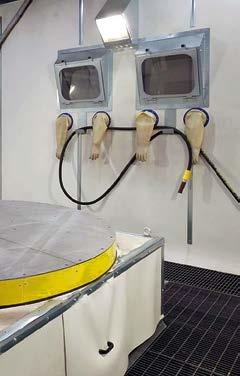
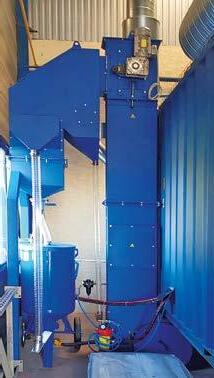
VOICES
eurotherm.eu Eurotherm
PLANT 1: 4.700
work
PLANT 2: 5.300
S.p.A. based in Turin, Italy
m2 of offices, metal
production and painting.
m2 for production, preassembling,
SHOT BLASTING BOOTHS with integrated complete grit recovery
NAVAL CONTAINER for shot blasting with integrated grit recovery system

BREAKTHROUGH 48 CORROSION PROTECTION | APRIL 2023 © Adobe Stock
RESEARCH
New corrosion protection that repairs itself
by Peter Rüegg, ETH Zürich – Zürich, Switzerland

Skyscrapers, bridges, ships, aeroplanes, cars –everything humans make or build sooner or later decays. The ravages of time are known as corrosion; nothing is safe from it. This makes the fight against corrosion expensive. All countries together invest around 3.5 percent of annual global gross domestic product in corrosion protection, which amounts to some 4,000 billion dollars: a huge market – and a gigantic problem.
Researchers at ETH Zurich led by Markus Niederberger and Walter Caseri from the Laboratory for Multifunctional Materials have now presented a new solution. Over the past years, they have developed a plastic that could greatly improve and simplify corrosion protection. Poly(phenylene methylene) is the miracle material’s name, or PPM for short. This new corrosion protection material kills several birds with one stone. When mixed as paint and heated, PPM can be sprayed onto a surface and becomes solid. The polymer indicates holes and cracks in the protective layer by failing to fluoresce. What’s more, it repairs any damage itself without further external intervention. And at the end of a product’s life, the polymer can be completely removed and recycled with only minimal material loss. The recycled polymer can then be applied to another surface with no loss in its special properties and functions.
49 APRIL 2023 | CORROSION PROTECTION
RESEARCH BREAKTHROUGH
ETH Zurich researchers have developed an extraordinary protection against corrosion after a chance discovery. It glows in places where it is not damaged, repairs itself – and can be reused multiple times.
Chance gave a helping hand
It was pure chance that kicked off this development. About ten years ago, researchers in Niederberger’s lab were working on the production of nanoparticles in a special organic solvent. Under certain conditions, the solvent became solid: it polymerised. “That was unintentional and unwanted,” Niederberger recalls. “We didn’t know what to do with it at first either.”
But then they discovered that the polymer they had created by accident – known as PPM – had another interesting property in addition to its high thermal stability: it fluoresced even though conventional knowledge suggested it should not be fluorescent at all. And so the researchers specifically refined the material. First, a doctoral student improved the polymer’s synthesis. After that, his successor, the doctoral student Marco D’Elia, was given the task of finding a useful application for PPM.
“And he did this job with flying colours,” says a delighted Walter Caseri, who supervised D’Elia. His contacts with corrosion experts at the Università degli Studi di Milano also proved fruitful, Caseri says.
Easy to use and versatile
Laboratory tests revealed that a PPM-based coating protects metals, especially aluminium, well against corrosion. Even though this protective coating can be applied in layers that are up to ten times thinner than conventional protective agents – such as

those based on epoxy resins – it is durable. Last but not least, the polymer seals any damage to the coating by itself. “Self-repair mechanisms are in great demand, but they’re very difficult to attain, and good solutions are still rare,” Caseri says. To achieve self-repair usually requires chemical additives, which migrate in the polymer over time and are released into the environment. Not so with PPM: “This material doesn’t require any additives,” Caseri says. PPM is also more sustainable than previous corrosion protection materials because it can be completely removed and recycled at the end of the product’s life. While some polymer material is lost in the process, the recycling rate is very high at 95 percent. In their tests, the researchers were able to reuse the material five times.
Studies on the sustainability of PPM-based corrosion protection also show that the polymer performs better than epoxybased corrosion protection materials when it comes to both environmental impact and human health. “There are really only two disposal solutions for epoxy resins: incineration or landfill,” D’Elia says. “Our product allows for a third solution: recycling.”
“Project shows versatility of materials science”
Nevertheless, PPM corrosion protection is not completely harmless to the environment. “Synthetic products always have an impact,” D’Elia says. “But if you choose the right approach, you can limit that impact to a great extent.”
50 CORROSION PROTECTION | APRIL 2023 RESEARCH BREAKTHROUGH
© ETH Zurich / Marco D’Elia
Fluorescent corrosion protection on a metal plate.
The former doctoral student hopes to see PPM corrosion protection commercialised.




The researchers have applied for a patent for their invention. It is still pending. They are also currently looking for an industry partner to further develop the product and to manufacture and distribute it on a large scale. Given the size of the global market, D’Elia sees huge potential for PPM. “Our technology is pretty advanced, but before we can sell it as a product, there are still some improvements for us to make,” he says.

Caseri, in turn, is proud of what has been achieved. The chemical synthesis, the characterisation of PPM’s molecular structure and the study of material properties that were not expected for this type of polymer – such as fluorescence –show “all the versatility of materials science.”
In addition, manufacturing, another mainstay of his department, also got a chance to shine, he says. “And now we have a great application. We’ve covered all these fundamental elements of materials science with this project.”
It also goes to show how important international cooperation is. In this project, the ETH researchers worked with partner universities in Spain, Austria and Italy as well as in the UK. ‹

RESEARCH BREAKTHROUGH
Walter Caseri, Marco D'Elia, Markus Niederberger (f. l. t. r.) worked on the development of the new corrosion protection material PPM.
© ETH Zurich / Martin Rütsche
GLASS FLAKE COATINGS COULD MEAN END TO OFFSHORE WIND SUBSTRUCTURE SURFACE MAINTENANCE
by Ismail Tan, Jotun A/S - Sandefjord, Norway
Glass flake polyester (GFP) coatings offer more than 30 years’ maintenance-free corrosion protection at the splash zone for offshore assets, according to a new independent report from classification society DNV.
The study shows that Baltoflake, a GFP solution developed by leading coatings manufacturer Jotun, provides decades of protection for offshore wind substructures and reduces lifecycle costs by up to 50%.
The high-performance coating is ideal for deployment in the offshore wind sector, where strong corrosion resistance and excellent mechanical properties are required.
DNV inspected a section of jacket from a North Sea oil platform which was installed in 1972 and decommissioned in 2020. Jotun’s Baltoflake coating was applied to the platform in the late 1980s

52 CORROSION PROTECTION | APRIL 2023
SUCCESS STORY
Jotun’s Baltoflake coating can provide maintenance-free protection at the splash zone beyond 30 years, according to new research.
and, despite over 30 years’ exposure to the North Sea’s harsh environment, analysis revealed that the coating at the splash zone was intact, still smooth and showing no signs of delamination. Ismail Tan, Global Category Manager - new construction primers, at Jotun said: “Although glass flake coatings have been used in the energy industry for over 40 years, there has traditionally been very little research into the material’s long-term benefits. However, by partnering with DNV on this report, we now have the relevant in-field data required to demonstrate Baltoflake’s full asset lifecycle protection performance. Baltoflake removes the requirement for offshore wind developers to undertake expensive repairs or replacement due to corrosion. By reducing overall maintenance costs and downtime, we can empower operators to focus their efforts on clean energy generation.”
DNV is an independent assurance and risk management provider, operating in more than 100 countries, with the purpose of safeguarding life, property, and the environment. As a trusted voice for many of the world’s most successful organizations, it helps seize opportunities and tackle the risks arising from global transformations. The company uses its broad experience and deep expertise to advance safety and sustainable performance, set industry standards, and inspire and invent solutions.
According to recent figures1, global installed offshore wind capacity is expected to reach 630 gigawatts (GW) by 2050, up from 40 GW in 2020. However, with global steel stocks and production declining following the pandemic, and with the war in Ukraine locking out around 10% of the global steel trade2, the cost of steel is skyrocketing while availability drops, putting pressure on offshore wind projects.
Offshore wind developers are at an increased risk of rising prices due to the large turbine sizes, longer foundation structures and substation requirements. However, with offshore turbines designed to last for 20-25 years, solutions like Baltoflake have the potential to extend the life of new and existing turbines by more than 10 years, reducing lifecycle costs by 50% in the process. Introduced during the 1970s, Baltoflake was one of the first performance coating products targeted for offshore environment deployment. The coating has glass flake materials incorporated into polyester to create structure that is 5–20 times more impermeable than resin alone.

Glass flake coatings have an outstanding corrosion resistance to a wide range of acids, alkalis, solvents and salt solutions, whilst displaying excellent thermal stability.
With decades of experience protecting assets in the harshest environments, Jotun, headquartered in Sandefjord, Norway, is a world leader in coatings for offshore structures. The company has developed high performance coatings for the offshore industry for more than 50 years.
The report was launched last year at ONS exhibition in Stavanger (Norway). ‹
1 https://www.mckinsey.com/industries/electric-power-and-natural-gas/our-insights/how-to-succeed-in-the-expanding-global-offshore-wind-market
2 Ukraine war causes global steel shortage (etmm-online.com)
53 APRIL 2023 | CORROSION PROTECTION SUCCESS STORY
High-performance composite repair solution for offshore risers reinforcement

edited by 3X Engineering, Monaco
lc@3xeng.com
3X was commissioned to perform a repair work of 19 risers of an offshore Oil&Gas structure in Qatar. In order to protect the risers in their splash zone was chosen the 3X composite solution REINFORCEKiT® 4D.
SUCCESS
54 CORROSION PROTECTION | APRIL 2023
STORY
© Adobe Stock
3X ENGINEERING (3X) is one of the world leading companies specialized in pipeline maintenance using composite technology. In October 2022, 3X ENGINEERING performed a repair work in order to protect (mechanical protection + impact resistance) 19 risers (from 8” to 20” OD) on their splash zones and thus prevent further deterioration of the risers. To do that, it was decided to protect the risers areas using 3X composite solution REINFORCEKiT® 4D.
The main R4D’s features REINFORCEKiT® 4D (R4D) is a wet layup system, wrapped helicoidally around the pipe in order to bring the mechanical resistance to the damaged pipe section. The number of layers, determined by calculation, is linked not only to the pipe pressure, temperature, diametre and thickness but also to the pit depth and length, the steel grade and the pipe location. The repair design and material requirements are provided by 3X software REA after information compilation according to ASME B31G, ISO 24.817 and ASME PCC-2 codes and standards.




REINFORCEKiT® 4D is recommended to repair and reinforce pipelines operating at temperature between -50°C (-58°F) up to +150°C (+302°F) subject to external/ internal corrosion, leaks (dedicated procedure for live repair), dents and mechanical damages. The system restores the pipe integrity and prevents from further deterioration. This composite sleeve is made of 400 g/m² Kevlar® tape and highly-reinforced ceramic epoxy resin.
Qatar case study: scope of work

According to ISO 24.817 standard and 3X calculations, it was decided to apply
6 layers of REINFORCEKiT® 4D (using R3X95 resin) on each riser to protect them from impacts and corrosion issues. Surface preparations were completed using sandblasting to remove coating and create a good surface roughness (superior to 60μm Rz) and ensure a good bonding between the steel pipes and the composite solution. Then hygrometric conditions were checked and the whole prepared surfaces were cleaned with air blower.
The composite applications were then completed following the main stages mentioned below (the procedure was the same for the 19 risers):
1 - One layer of R3X95 resin was firstly applied on the prepared surface to ensure the good impregnation of the first tape layer.
2 - Composite wrapping was then completed using Kevlar® tape impregnated with R3X95 resin. Six layers were applied on each riser with a repair length between 7220mm and 9200mm. A total of over 175m repair length using REINFORCEKiT® 4D product was installed on the 19 risers.
3 - Last layer of R3X95 resin was applied all over the wrappings as finalization stage and id plate was installed for traceability.
4 - Eight hours after, coating was applied on the composite protection.
Results
Samples of resin were taken during each tape impregnation for quality control and hardness measurements were performed and validated on site and in 3X offices. The 19 risers are now protected with REINFORCEKiT® 4D from impacts and corrosion issues that could affect their mechanical resistance. The design life for each riser for this composite protection is 20 years. ‹
THE WORK AT A GLANCE
Defect types details: Mechanical protection - 19 risers. From 8" to 20" gas risers, straight line, max. operating temp. 70 °C, calculated pressure 60 bars.
Location: Qatar, offshore.
3X solution: REINFORCEKiT® 4D.
55 APRIL 2023 | CORROSION PROTECTION SUCCESS STORY
Local intensification of general corrosion attack in quenched and tempered steel: the role of inclusions
 by Francesco Andreatta* and Matteo Zanocco University of Udine, Polytechnic department of engineering and architecture - Udine, Italy
by Francesco Andreatta* and Matteo Zanocco University of Udine, Polytechnic department of engineering and architecture - Udine, Italy
Stefano Virgilio
Wärtsilä Italia S.p.A. - San Dorligo della Valle (Trieste), Italy
*Corresponding author: francesco.andreatta@uniud.it
SCIENCE OUTLOOK
56 CORROSION PROTECTION | APRIL 2023
Adobe Stock
©
Inclusions in 42CrMo4 QT steel
The 42CrMo4 QT is typically employed in the oil&gas, offshore and marine industry due to its high mechanical strength combined with good toughness in the quenched and tempered condition (QT) [1–4] which was processed with the intent of having fewer and smaller inclusions, was compared with regular grade SS304. Transmission electron microscopy (TEM). Inclusions are unavoidable in steels and can be produced during steel deoxidation or during the cooling of the melt in the steelmaking process [5–8]. Typical inclusions include alumina, silica, manganese sulphide or complex oxy-sulphide inclusions in the case of Ca treated steels [6–8]. In particular, Ca treatment of 42CrMo4 steel improves its fatigue resistance trough the formation of globular inclusions consisting of a core of alumina and a (Ca,Mn)S outer shell [7].
The inclusions in 42CrMo4 QT steel (composition given in Table 1) were characterized by means of field emission – scanning electron microscope (FE-SEM). Figure 1 shows an example of a typical oxysulphide inclusion with size of about 5 μm.
As it can be seen in the elemental maps obtained by energy dispersive x-ray spectroscopy (EDXS), the core of the inclusion consists of alumina. The outer part of the inclusion exhibits the signals of Mn, S and Ca.
This is related to the nucleation of MnS on the alumina core promoted by the Ca treatment of the steel. As a result, the MnS outer part of the inclusions contains Ca. A narrow gap can be appreciated at the periphery of the globular inclusion.
Topography and surface potential of the inclusions
Non-metallic inclusions like the one shown in Fig. 1 can cause localized attack in the form of pitting [9–12]. In order to evaluate the role of the inclusions in the initiation of pitting corrosion, the microstructure of 42CrMo4 QT steel was investigated by means of an atomic force microscope. This technique was used to evaluate the topography at inclusion sites. Figure 2A shows the topographic map of a core-shell oxy-sulphide inclusion similar to that shown in Fig. 1.
The narrow gap between the inclusion and the surrounding steel matrix is clearly visible in the topographic map. Figure 2B shows the surface potential map (Volta potential) for the same region containing the inclusion. The outer shell of the inclusion appears brighter than the surrounding matrix. The potential difference between the shell of the inclusion and the matrix is about 70 mV. This indicates that the shell of the inclusion is more noble than the matrix and would be the cathode in the local galvanic couple with the steel matrix in the presence of an aggressive electrolyte. The core of the inclusion exhibits similar contrast to that of the matrix suggesting that the core of the inclusion would establish a weak galvanic couple with the surrounding steel.
The existence of a Volta potential difference between inclusions and steel matrix (as shown in Fig. 2B) has been often correlated in literature to localized attack in the form of pitting [11, 13, 14]. Besides, this is associated to a deep and narrow gap at the periphery of the inclusion that could provide conditions favourable to crevice corrosion.
57 APRIL 2023 | CORROSION PROTECTION SCIENCE OUTLOOK
C Si Mn P S Cr Mo Al 42CrMo4 QT steel 0.3800.450 max 0.400 0.6000.900 max 0.035 max 0.035 0.9001.200 0.1500.300 0.3800.450
Structural steels like 42CrMo4 QT might be susceptible to localized attack in aggressive environments with a negative effect on their durability and mechanical properties. The driving force for the initiation of pitting corrosion in 42CrMo4 QT steel is the existence of local galvanic couples between the inclusions and the steel matrix. The localized attack can be enhanced by narrow and deep gaps at the periphery of inclusions trough a crevice corrosion mechanism.
Table 1: Chemical composition of 42CrMo4 QT steel.
The existence of such gaps is well known in literature and is the result of the different thermal expansion coefficient and deformability of the inclusions with respect to the matrix [9, 11]. This leads to the formation of the gaps during thermo-mechanical processing of the high strength steel.
Localized corrosion at the inclusions
Galvanostatic polarization measurements (current density of 1 mA/cm2 for 1 h) were carried out in order to evaluate the onset of localized attack in the 42CrMo4 QT steel. These measurements were carried out in 0.1M NaCl solution with 3 g/l Na2SO4. After the electrochemical test, the surface of the samples was inspected by FE-SEM in order to evaluate the morphology of attack.

Figure 3 shows an example of the appearance of the surface of the 42CrMo4 QT steel after the galvanostatic polarization test. The steel surface displays several pits (indicated by the arrows).

Moreover, the steel matrix exhibits general corrosion due to the attack of the tempered bainite in the matrix. The intensification of the attack in the form of pitting revealed in the galvanostatic polarization measurements was further investigated combining immersion tests with FE-SEM characterization. The surface of 42CrMo4 QT steel was initially characterised by means of FE-SEM to locate the inclusions and to obtain their chemical composition. Successively, the samples were immersed in 0.1M NaCl solution + 3 g/l Na2SO4 and inspected at different immersion times to observe the morphology of attack. Figure 4 reports FE-SEM images of a region containing an oxy-sulphide inclusion similar to that shown in Fig. 1 before and after the immersion for 3 h in the testing electrolyte. Before immersion, the composite structure of the inclusion and the gap at its periphery can be clearly recognized. After 3 h immersion, a large pit was formed at the site of the inclusion, which is no longer visible.

58 CORROSION PROTECTION | APRIL 2023 SCIENCE OUTLOOK
1 2 3
Fig. 1 - FE-SEM micrograph and EDXS elemental maps for an inclusion in 42CrMo4 QT steel.
Fig. 2 - AFM topographic map of the surface of 42CrMo4 QT steel (A) and SKPFM surface potential map of the same region (B).
Fig. 3 - SEM micrograph showing pitting attack on the surface of 42CrMo4 QT steel after galvanostatic polarization in 0.1M NaCl solution + 3 g/l Na2SO4.
This clearly demonstrate that the localized attack shown in Fig. 3 preferentially initiates at the oxy-sulphide inclusions sites in 42CrMo4 QT steel. The fast initiation of the attack is due to the potential difference between the inclusion and the steel matrix, which is mainly due to the Ca-rich MnS shell with cathodic behaviour relative to the steel matrix. This can be considered the driving force for the intensification of the attack at the inclusions. Besides, the steel matrix surrounding the particle is generally attacked in line with the morphology observed after galvanostatic polarization (Fig. 3). This is related to the low corrosion resistance of the tempered bainite in the testing electrolyte. The role of the gap at the periphery of the inclusion should be also considered. As considered above in the discussion of the AFM topographic image (Fig. 2A), the gap can promote crevice corrosion, which most likely is responsible for the detachment of the inclusion from the steel matrix. Therefore, the morphology of attack shown in Fig. 4 suggest a synergistic effect between the

References
galvanic coupling between the inclusion and the matrix and the crevice corrosion related to the gap at its periphery.
Conclusions
The localized attack of 42CrMo4 QT steel takes place at the sites of complex oxysulphide inclusions. The driving force for the onset of the attack is related to potential differences between the inclusions and the surrounding steel matrix leading to galvanic coupling with the steel matrix in the presence of an aggressive electrolyte. The general corrosion mechanism is coupled with non-uniform morphologies at narrow and deep gaps at the periphery of the inclusions during thermo-mechanical processing of the steel likely associated to the galvanic coupling. Marked uniform corrosion of the 42CrMo4 QT steel was noticed in 0.1M NaCl solution with 3 g/l Na2SO4, as expected, alongside with more localized effects at the inclusion sites. Results of this work highlight the importance of quality control in the production of high strength steels in order to improve their durability. ‹
1. Jun, J.; Holguin, K.; Frankel, G.S. Pitting Corrosion of Very Clean Type 304 Stainless Steel. Corrosion 2014, 70, 146–155, doi:10.5006/0995.
2. Zhu, M.; Deng, Z. Evolution and Control of Non-Metallic Inclusions in Steel During Secondary Refining Process. Jinshu Xuebao/Acta Metall. Sin. 2022, 58, 28–44, doi:10.11900/0412.1961.2021.00227.
3. Behrens, B.A.; Brunotte, K.; Petersen, T.; Diefenbach, J. Mechanical and Thermal Influences on Microstructural and Mechanical Properties during Process-Integrated Thermomechanically Controlled Forging of Tempering Steel AISI 4140. Materials (Basel). 2020, 13, 1–13, doi:10.3390/ma13245772.
4. Malau, V.; Fauzi, W.I. Effects of Heat Treatments on Mechanical Properties, Specific Wear and Corrosion Rate of HQ 809 Steel for Machinery Components Application. Proc. - 2018 4th Int. Conf. Sci. Technol. ICST 2018 2018, doi:10.1109/ICSTC.2018.8528600.
5. Wagner, R.; Schmiedel, A.; Dudczig, S.; Aneziris, C.G.; Volkova, O.; Biermann, H.; Weidner, A. Tailoring Nonmetallic Inclusions in 42CrMo4 as a Preparative Tool for Active and Reactive Steel Melt Filtration. Adv. Eng. Mater. 2022, 24, doi:10.1002/adem.202100640.
6. Weidner, A.; Krewerth, D.; Witschel, B.; Emmel, M.; Schmidt, A.; Gleinig, J.; Volkova, O.; Aneziris, C.G.; Biermann, H. Microstructure of Non-Metallic Inclusions Identified in Cast Steel 42CrMo4 after Metal Melt Filtration by Novel Foam Filters. Steel Res. Int. 2016, 87, 1038–1053, doi:10.1002/srin.201500462.
7. Zhang, L.; Thomas, B.G. State of the Art in the Control of Inclusions during Steel Ingot Casting. Metall. Mater. Trans. B Process Metall. Mater. Process. Sci. 2006, 37, 733–761, doi:10.1007/s11663-0060057-0.
8. Abraham, S.; Bodnar, R.; Raines, J.; Wang, Y. Inclusion Engineering and Metallurgy of Calcium Treatment. J. Iron Steel Res. Int. 2018, 25, 133–145, doi:10.1007/s42243-018-0017-3.
9. Liu, P.; Zhang, Q.H.; Watanabe, Y.; Shoji, T.; Cao, F.H. A Critical Review of the Recent Advances in Inclusion-Triggered Localized Corrosion in Steel. npj Mater. Degrad. 2022, 6, 1–17, doi:10.1038/ s41529-022-00294-6.
10. Li, Y.; Liu, J.; Deng, Y.; Han, X.; Hu, W.; Zhong, C. Ex Situ Characterization of Metallurgical Inclusions in X100 Pipeline Steel before and after Immersion in a Neutral PH Bicarbonate Solution. J. Alloys Compd. 2016, 673, 28–37, doi:10.1016/j.jallcom.2016.02.224.
11. Liu, C.; Yuan, H.; Li, X.; Che, Z.; Yang, S.; Du, C. Initiation Mechanism of Localized Corrosion Induced by Al2O3-MnS Composite Inclusion in Low-Alloy Structural Steel. Metals (Basel). 2022, 12, 1–10, doi:10.3390/met12040587.
12. Liu, C.; Revilla, R.I.; Zhang, D.; Liu, Z.; Lutz, A.; Zhang, F.; Zhao, T.; Ma, H.; Li, X.; Terryn, H. Role of Al2O3 Inclusions on the Localized Corrosion of Q460NH Weathering Steel in Marine Environment. Corros. Sci. 2018, 138, 96–104, doi:10.1016/j.corsci.2018.04.007.
13. Liu, C.; Revilla, R.I.; Liu, Z.; Zhang, D.; Li, X.; Terryn, H. Effect of Inclusions Modified by Rare Earth Elements (Ce, La) on Localized Marine Corrosion in Q460NH Weathering Steel. Corros. Sci. 2017,
SCIENCE OUTLOOK
129, 82–90, doi:10.1016/j.corsci.2017.10.001.
14. Man, C.; Dong, C.; Xiao, K.; Yu, Q.; Li, X. The Combined Effect of Chemical and Structural Factors on Pitting Corrosion Induced by MnS-(Cr, Mn, Al)O Duplex Inclusions. Corrosion 2018, 74, 312–325, doi:10.5006/2581.
59 APRIL 2023 | CORROSION PROTECTION
Fig. 4 - SEM images of a region containing an inclusion before and after 3h immersion in 0.1M NaCl solution + 3 g/l Na2SO4.
THE INDUSTRY MEETING
Polyurea and its revolutionary uses: the successful presentation of Graco’s reactor proportioners
On 17 March 2023, the Vergallo Group’s corporate headquarters in Corigliano d’Otranto (Lecce, Italy) hosted an exclusive presentation event of the Reactor polyurea proportioners produced by Graco, a leading American company. The VECO Equipment division of the Vergallo Group, which is a distributor of Graco’s products for Italy, Albania, and Malta, provided the workshop’s participants with a unique opportunity to explore the potential of polyurea and learn about the advantages of this material in the production and processing of steel and precast concrete.

Graco’s Reactor proportioners are currently the world’s most advanced systems for spraying polyurea, a highly resistant waterproofing material. Polyurea is already being successfully utilised in many applications and sectors, including the military and defence sector.
Indeed, armed forces around the world, including the US ARMY, US NAVY, and US AIR FORCE, take advantage of its water, flame, explosion, EOD (Explosive Ordnance Disposal), weathering, and corrosion resistance.
The event offered a detailed overview of the many applications of polyurea, showing the ways in which this material can be used in
the production of steel and precast concrete. Participants had the opportunity to discuss directly with company executives about the possible applications of this technology in their own production and work activities.
Among the highlights of the event, speakers emphasised the unique properties of polyurea, including as follows:
high wear and abrasion resistance: polyurea ensures durable protection against wear and abrasion, making it ideal for industrial and military applications;
impermeability: due to its chemical structure, polyurea forms a waterproof barrier that prevents the infiltration of water and moisture.
chemical resistance: polyurea resists a wide range of chemicals, including oils, fuels, and solvents, guaranteeing reliable protection in aggressive environments.
flexibility and adaptability: polyurea can be applied to different surfaces, adhering perfectly to materials such as metal, concrete, and wood, conforming to their shapes and textures.
The success of the event is proof of the growing interest in the use of polyurea in the steel and precast concrete production and
60 CORROSION PROTECTION | APRIL 2023
processing sectors. Now, thanks to the collaboration between Vergallo and Graco, Italian, Albanian, and Maltese companies can have access to innovative polyurea-based solutions that improve the quality and durability of their products.
In addition to informative presentations, the event included live demonstrations of polyurea application using Graco’s Reactor proportioners. These allowed participants to observe first-hand the effectiveness and versatility of this innovative material and, at the same time, the potential offered by the Reactor spraying systems.
Discussions between participants and company representatives highlighted further opportunities for the use of polyurea in various sectors, including the construction, civil engineering, petrochemical, and renewable energy ones. In addition, polyurea could have a significant impact on corrosion prevention and on the protection of critical infrastructure, including bridges, dams, and pipelines.
Therefore, the presentation of Graco’s Reactor polyurea proportioners organised by Vergallo was an important event for industry professionals interested in learning about the latest innovations and the potential offered by polyurea.
The collaboration between Graco and Vergallo now enables Italian, Albanian, and Maltese companies to benefit from state-of-the-art solutions that improve the quality and durability of their products by taking advantage of the extraordinary properties of polyurea.

www.vecoequipment.com
There are over 10,000 Level I, II and III inspectors in 74 countries worldwide, as large clients consider the qualification of Coating Inspector Frosio as a reference for monitoring the quality of the application of a painting cycle.
There are 367 active Certifications in Italy, of which 109 Level I (white card), 115 Level II (Green card) and 143 Level III (red card). The certification is in accordance with the Frosio Certification SCHEME, which follows the requirements of ISO 17024.
The University of Genova, accredited by FROSIO as a Training Body, is in charge of organising courses in the Italian language exclusively for the Italian territory. To date, 20 courses have been organised.


The Gruppo IspAC Associazione (GIA), accredited by FROSIO as Certifying Body, is in charge of organising the exams for the Qualification and Certification of Coating Inspectors Level I, II and III, renewal of certifications and level ups exclusively for the Italian territory. Gruppo

MEETING THE INDUSTRY
www.gruppoispac.org University of Genova
IspAC Associazione (GIA) segreteria@gruppoispac.org
frosioitalia@unige.it www.perform.unige.it/corsi/corso-frosio
SIFER beats all attendance records for this 13th edition
Organised in the centre of Europe’s railway region, SIFER – the only international rail event in France – confirmed again its pivotal position in the French railway industry.


A total of 7000 visitors walked along the aisles of Lille Grand Palais during this 13th edition of SIFER, from 28 to 30 March. The event hosted 378 exhibitors, of whom 24% were new participants, coming from 20 countries, accounting for 22% of international companies. With the support of partners and exhibitors, 43 sessions and 20 associated events (conferences, round tables, workshops, presentations) were organised.
This record attendance underlines the dynamism of the sector, which is revolving around a major topic: innovation, in response to competitivity and climate issues. The French railway industry is indeed launched at full speed.
SIFER – The one event reuniting the industry
For 20 years, SIFER has acted as an emulator on behalf of the actors of the sector by offering an ideal platform to debate and discuss the future of the sector: “SIFER is the most attractive exhibition in which we participate because its size allows quality interactions and we appreciate the diversity of the visitors we meet: customers, partners, prospects” – Stéphane Celle, Sferis Sales Manager.
It is therefore no coincidence that the FIF (French Railway Industries Association) decided to launch the 2nd part of CORIFER, the Steering Committee for Research and Innovation in the Railway Sector. This CORIFER 2, meant to “accelerate industrialisation”, according to its vice-president Carole Desnot, encompasses 4 major themes: Smart Industry, Smart Train, Green Train and Inclusive Mobility. Topics that were at the heart of the discussions of the show: “without research and innovation, you die” said Louis Nègre, President of the FIF, during the Opening Ceremony. “Inflation, supply disruptions, the attractiveness of the sector...: it is necessary to fight on all these subjects” added Philippe Citroën, President of UNIFE.

The FIF Village - a brand new space at the show
This year, the presence of the French Railway Industries Association grew in power by offering a space where conferences and presentations were held on topics ranging from European rail recovery plans to decarbonisation, innovation and the attractiveness of the sector.
MEETING THE INDUSTRY
Among the highlights proposed: the CS2F Steering Committee, upcoming projects in the regions, or the presentation of CORIFER’s 4 roadmaps.
Innovation, a renewed ambition materializing

For the first time, SIFER welcomed innovative start-ups in a common dedicated space: the Innovation Hub. 8 companies were able to show projects with a high potential to enhance the skills competitivity in the sector. The innovative Light Rail was also put in the spotlight during a conference hosted by IRT Railenium, and at the Railway Innovation Awards Ceremony organised by i-Trans. The SNCF was rewarded for this project, which was considered by its director Jacques Berling “a jump in performance similar to that of the TGV at the time, but at the territorial level”. The Rail Open Lab round table demonstrated the ability of an Open Association to accelerate innovation. AIF addressed the subject of cybersecurity, a major topic in today’s rail reality.
Results of the i-Trans Rail Innovation Awards

“Best Large Company” category: SNCF for the innovative Light Rail project.
“Best SME” category: Moïz, a start-up from the CNRS laboratory in Grenoble, developing a connected measurement module without batteries or wires.
“Jury’s favourite” prize: LIB Ferroviaire and its ThioTrack innovation, a green crossing approved by SNCF.
“SIFER is a great networking platform. This year is our first participation as an exhibitor, in the Innovation Hub. We came to show our project and prospect within the sector in order to make our new tool well known” – Florent Busson, Director of travauxferroviaires.com
“SIFER allows us to meet many clients in a short amount of time, whereas normally we would have to travel all across France to meet them. We also appreciate the exhibition for the new contacts that we create. This year, the environment was the major topic with many questions about the recyclability of our products” – Pierre Lecomble, Commercial Strail France
The next edition of SIFER will take place from 24 to 26 June 2025.
www.sifer-expo.com
MEETING THE INDUSTRY
OMC: alliances, cooperation and sustainability
OMC - Med Energy Conference and Exhibition is the not-tomiss meeting in Ravenna (Italy), which over the years has been recognised as the main hub for energy issues in the Mediterranean. This year edition will be held in May, from 23th to 25th, and will be an opportunity to celebrate the 30th Anniversary of the event. The goal is to re-discuss the energy industry from the perspective of energy transition, respecting the principles of sustainable development. After the OMC participation - for the first time - in the COP27 in Sharm-el-Sheikh in November 2022, the need for an alliance between the countries of the North and South Mediterranean has become even more evident. OMC, as a physical and metaphorical meeting place between stakeholders and institutions from all over the world, has always prized the Mediterranean and its crucial role, which has shaped the history of culture and civilization, a meeting point between the cultures of the world.
Ravenna confirms itself, edition after edition, as the energy capital for the Mediterranean, in the centre of discussions and reflections on the transition path underway, and as a place where, thanks to OMC, all interested parties – consumers, energy producers and institutions – meet and cooperate with each other to build synergetic solutions. The 2023 edition will also be an opportunity to focus attention on local and national energy security and supply plans: in fact, Ravenna plays its role to offer for the transition and the improvement of the country’s energy security, with planning and implementing of many important projects at the local level. Alliance, sharing and cooperation facilitate the development of conventional and renewable energy resources, to diversify sources in Europe and increase the energy independence of countries. Technological neutrality is one of the fundamental pillars of the
OMC: all energy sources must be exploited and used to the fullest, in an energy mix that always has the drastic reduction of climate-changing emissions as its objective. The approach is holistic, therefore it involves the circular economy, bio-products and decarbonisation tools (such as CCS and CCUS), all this is intended to improve the efficiency and sustainability of processes. In May 2023 we will then talk about the future: startups, students, universities will have large space within the event. The Innovation Room will be dedicated to their contributions, to include them in a contest, thus increasing the dialogue between companies and the academic world and creating new skills.
The next edition will welcome 16,000 participants and 500 exhibiting companies. OMC will host over 30 key players of the energy industry, Ministers, CEO’s, and Managing Directors from 25 countries, as well as more than 200 technical sessions, a tangible sign of the commitment of all international actors involved in the organization of OMC: associations, public, media and private, and of course, exhibitors in the first place. It will be a unique opportunity for the participants to interface with customers and suppliers, find new partners and consolidate existing relationships, having available networking spaces open to the public, such as the B2B Energy Business Meetings area and the Commercial Presentation Theater where companies will be able to take turns on stage to present their products, services and know-how in front of an audience of industry professionals.


The world of energy will meet in Ravenna, we look forward to welcoming you!
www.omc.it
64 CORROSION PROTECTION | APRIL 2023 MEETING THE INDUSTRY
Leading operators and the Cypriot Government united to develop the Eastern Mediterranean energy industry in 2023
The Eastern Med is fast becoming one of the hottest sustainable energy basins in the world and with continued project expansion from the majors including TotalEnergies, Eni and Chevron as well as a renewed impetus to develop E&P prospects, gas processing and LNG infrastructure across the region, the Eastern Med looks set to continue its rapid development trajectory. With this in mind and led by the Government of Cyprus, the EMC team have brought together the leading operators and government stakeholders including Chevron, ENI Cyprus, TotalEnergies Cyprus, NewMed Energy, ExxonMobil, Energean Greece, Saipem, ENPEDCO, CHC, HEREMA, DEFA, EPE, to name a few to form EMC 2023’s advisory board to help guide the development of the EMC 2023 programme that will act as the premier decision-making platform for developments in the region.
Eastern Med energy developments continued at pace in February & March
With an estimated 122 tcf of natural gas spanning the deep offshore plays of the region, there have been several major new developments to note in the past month and the next six to twelve months look to be an important period in the development of the energy basin – with so much at stake, EMC 2023 is a must attend for anyone looking to operate in or enter the Eastern Mediterranean energy community. March and February saw a fever pitch of activity with a number of new bidding rounds announced by Cairo, whose sole aim is to take domestic production to the next level and set the strategically important nation on the path to becoming an exporter of LNG. Israel too has seen a stack of new field developments and further collaboration with Egypt has meant that the prospect of a new FLNG unit in the Leviathan field. Sharing common acreage and with similar

natural gas deposits of around 30-35 tcf, Israel and Egypt offer one another an expedient energy partnership. Similarly eyeing the prospects of energy independence and hard currency revenues of offshore gas, Lebanon this month also announced plans to begin drilling offshore by the summer. A key corporate and industry hub for the burgeoning energy markets in the Eastern Mediterranean, Cyprus too has announced that its much-vaunted LNG jetty terminal is close to completion and with record levels of planned investments into the offshore gas plays, the island nation looks determined to become not only an operational hub but also a corporate partner for its partners across the region. Unrivalled by any other forum and with thousands of attendees, #EMC2023 is both a must attend for anyone operating in the area and for anyone looking to enter this lucrative and up and coming frontier energy sector.
What is EMC? Join the East Med energy community!
Held over 3 days – from 28th to 30th November - in Limassol (Cyprus), this exhibition will offer the opportunity to meet new contacts, consolidate existing relationships and participate in nearly 30 panel and keynote speaker sessions designed specifically to develop the strategies needed to overcome the challenges of moving toward a sustainable energy transition. With support from the highest levels of government and industry, EMC 2023 is a unique forum and platform that allows the leading players in the region to help decide and drive the future of the Clean-Energy revolution. We look forward to welcoming you to our brand-new EMC home – the Limassol Exhibition Venue at City of Dreams Resort. Welcome to what will be a must-attend event in 2023!
www.emc-cyprus.com
MEETING THE INDUSTRY
Railtex 2023: full steam ahead with powerful partnerships, a strong line-up of new exhibitors and an exciting programme

The show provides a unique opportunity to meet with national and international players and thought leaders, all looking to enhance the passenger experience, freight logistics and the overall efficiency of railway operations. Participants can expect live demonstrations of new machines and systems, technical in-person discussions and a rich supporting programme packed with keynote speakers from leading industry names. Railtex will once again reinforce its role as the central marketplace for the industry to come together and discuss both challenges and opportunities in the light of current developments within the rail industry.
Keeping the current rail market in mind, it is particularly important to focus on crucial topics such as decarbonisation and investments to create a more sustainable rail industry, the digitalisation of rail transport, as well as the passenger experience. It is essential to not only address and mirror these topics, but to also come together to find common solutions and shape a successful future for the rail industry. This is precisely what Railtex facilitates. “Railtex 2023 is the place to be with all key players gathered in one place. We are glad to have the great support from our main show partner RIA – the Railway Industry Association, as well as our show partners, Rail Forum, Railway Benefit Fund, the CPD Certification Services, our media partners, and many more.” states Olaf Freier, the Transport Portfolio Director.
Network Rail and The Great British Railways Transition Team (GBRTT) as part of an extensive supporting programme
As the leading one-stop-shop event for the entire railway industry in the UK, Railtex reflects the dynamic developments in the sector and the vision of the rail network of the future via an exciting supporting programme.
“We are delighted that the Railway Industry Association will be the main show partner at Railtex 2023, providing an extensive programme across the event. Our programme this year is bigger than ever and includes a Future Focus Conference, to provide an environment where strategic discussions on the future of UK rail can take place, an Innovation Village, where key clients, stakeholders and suppliers will showcase what they are doing on innovation, the RIA Networking Zone and Meet the Buyer programme to support companies looking to get new products and services onto the network, and a Young Rail Professional
Conference, bringing a new generation in rail to the show.” says Darren Caplan, Chief Executive of the Railway Industry Association.
The programme will include keynotes, Q&A sessions and panel discussions held by a remarkable line-up of speakers, including leading figures from politics and industry and many other valuable actors from the rail industry, with the participation of Network Rail and The Great British Railways Transition Team. All sessions are free to attend and CPD certified. More details will be published in the run-up to the show. The Innovation Village will be part of the ‘Unlocking Innovation’ programme, organised by RIA and supported by Network Rail’s R&D Portfolio. Furthermore, the show features the popular On-Track Display area, sponsored by long-standing partner British Steel. It demonstrates tools and equipment in an authentic rail setting.
Strong line-up of new exhibitors: products and services at the show
So far, fifty new companies are amongst the exhibitors that have already confirmed their participation at Railtex 2023, all serving the future development of the UK railway industry with their products and services. Both the Railtex Exhibitor List tool and the Online Show Preview with detailed information on the many exhibitors and products are regularly updated and available at www.railtex.co.uk. The Exhibitor List tool helps users to effectively prepare for their visit by finding the companies and products most relevant to them. The Online Show Preview provides an overview of the wide variety of innovations, technologies and systems on display at the event.
www.railtex.co.uk
66 CORROSION PROTECTION | APRIL 2023 MEETING THE INDUSTRY
WE'VE BEEN WHERE
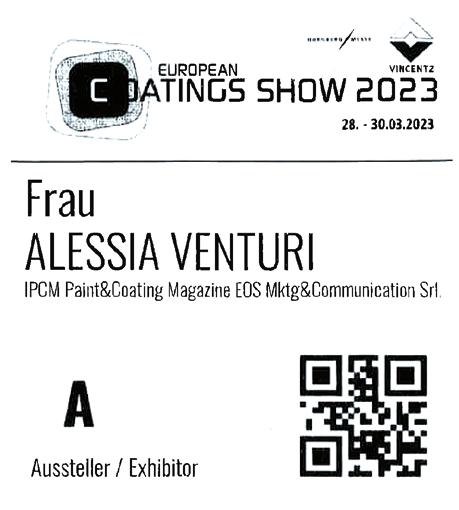
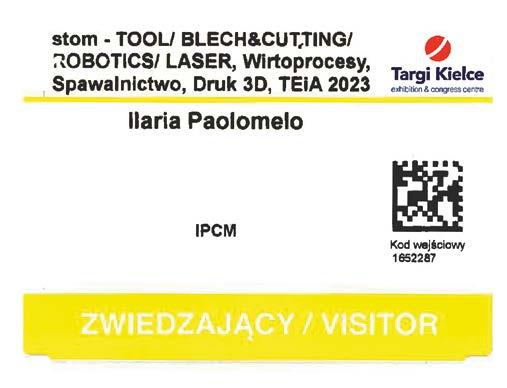
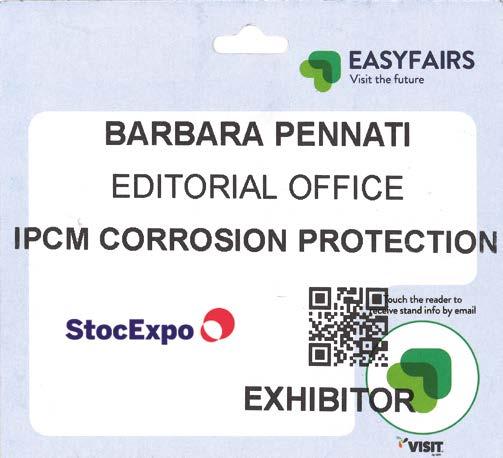
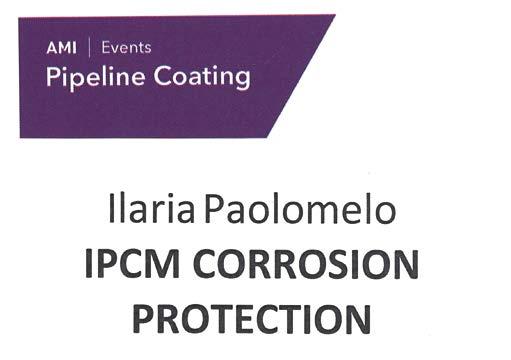
67 APRIL 2023 | CORROSION PROTECTION
EDITOR IN CHIEF
ALESSIA VENTURI venturi@ipcm.it
EDITORIAL OFFICE
PAOLA GIRALDO giraldo@ipcm.it
MONICA FUMAGALLI fumagalli@ipcm.it
MATTEO SOTTI sotti@ipcm.it
BARBARA PENNATI pennati@ipcm.it
ILARIA PAOLOMELO paolomelo@ipcm.it
FEDERICA BARISON segreteria@ipcm.it
GABRIELE LAZZARI redazione@ipcm.it
MEDIA SALES
FRANCESCO STUCCHI stucchi@ipcm.it
ILARIA PAOLOMELO paolomelo@ipcm.it
BARBARA PENNATI pennati@ipcm.it
NICOLE KRAUS kraus@ipcm.it
CLAUS GÖRLICH goerlich@ipcm.it
GRAPHICS
ELISABETTA VENTURI grafico@ipcm.it
TRANSLATIONS
CHIARA FOPPA PEDRETTI chiara.foppapedretti@gmail.com
PRINT
JONA SRL | www.jonasrl.it
Registrazione al Tribunale di Monza N° 4 del 26 Marzo 2012
Eos Mktg&Communication srl è iscritta nel Registro degli Operatori di Comunicazione con il numero 19244
POSTE ITALIANE S.P.A. – SPEDIZIONE IN ABBONAMENTO

POSTALE D.L. 353/2003 (CONV. IN L. 27/02/2004 N.46)
ART. 1, COMMA 1 LOM/MI/4352

an ipcm® magazine
EDITED BY
Eos Mktg&Communication srl

Via Pietro Mascagni, 8 - 20811 Cesano Maderno (MB) - Italy Tel. +39.0362.503215 - Fax. +39.0362.1794768
www.eosmarketing.it - info@eosmarketing.it | www.myipcm.com - info@ipcm.it
EDITORIAL DIRECTOR
Marco Ormellese, Politecnico di Milano
EDITORIAL BOARD
Annalisa Acquesta, University of Naples
Francesco Andreatta, University of Udine
Mehdi Attarchi, Senior Materials & Corrosion Specialist
Andrea Balbo, University of Ferrara
Hadi Beirami, Cathodic Protection Certified Specialist
Marco Cattalini, AMPP Italy Chapter Chairman
Jérôme Crouzillac, BAC Corrosion Control
Sergio Lorenzi, University of Bergamo
Tullio Monetta, University of Naples
Tomáš Prošek, University of Prague
Edoardo Proverbio, University of Messina
Stefano Rossi, University of Trento
Monica Santamaria, University of Palermo
SUBSCRIPTION SERVICE
Sale only on subscription e-mail: info@ipcm.it
Subscription Rates 2023
Annual subscription printed + digital: EMEA € 80,00 (postage included)
Rest of world € 250,00 (fast airmail shipping included)
Single copy: € 20,00 EMEA (postage included) - Rest of world (postage excluded)
Back issues: € 40,00 EMEA (postage included) - Rest of world (postage excluded)
Subscriptions can be made by bank transfer to the following account:
Eos Mktg&Communication Srl - IBAN IT97F0844033270000000084801 - SWIFT CODE: CRCBIT22 or online payment at: www.myipcm.com
It is forbidden to reproduce articles and illustrations of “ipcm® Protective Coatings” without authorization and without mentioning the source. The ideas expressed by the authors do not commit nor magazine nor Eos Mktg&Communication S.r.l and responsibility for what is published is the authors themselves.
UNIONE COSTRUTTORI IMPIANTI DI FINITURA









































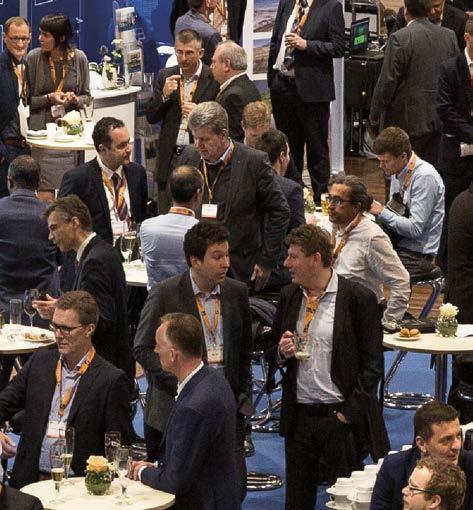







































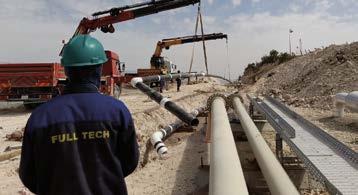























































Connect • Share • Expand Meet the International pipeline community www.pipeline-conference.com #ptcBerlin 8–11 MAY 2023, BERLIN 18TH PIPELINE TECHNOLOGY CONFERENCE AN EVENT BY
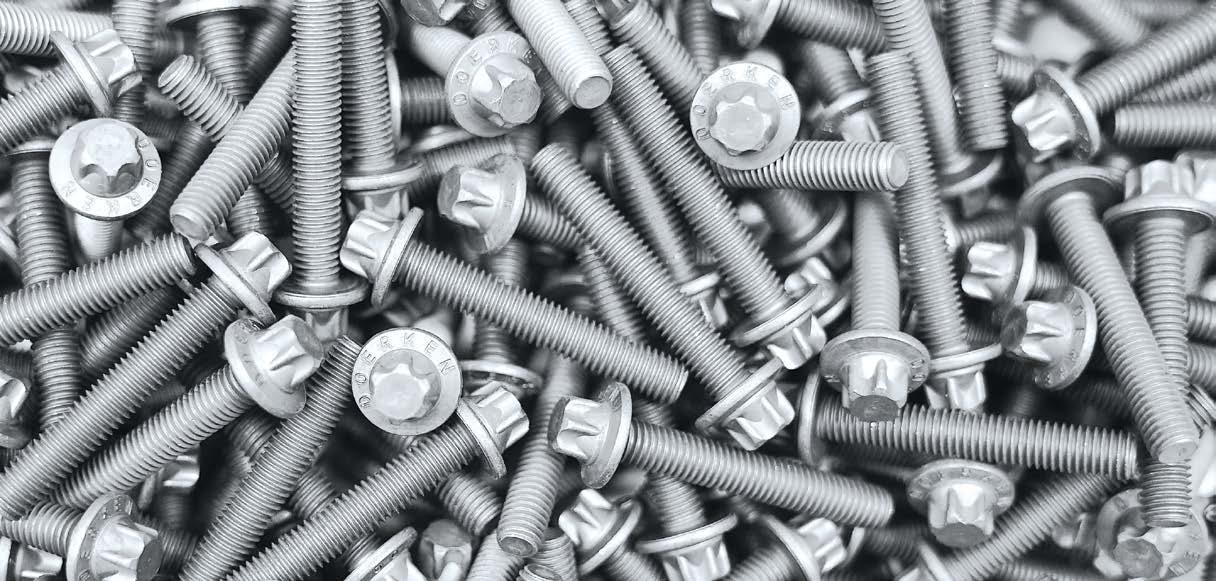
www.doerken.com Very stable friction properties PTFE-free Strong process stability THE STABLE ONE DELTA-PROTEKT ® TC 502 GZ MORE? Silver hybrid topcoat DELTA-PROTEKT ® TC 502 GZ is a silver hybrid topcoat with excellent friction properties for use on metric components. INDUSTRIAL COATINGS






































 by Alexander Ruiz Belzona – Miami Lakes (FL) – United States aruiz@belzona.com
by Alexander Ruiz Belzona – Miami Lakes (FL) – United States aruiz@belzona.com


























































 Spain
Spain























 by Francesco Andreatta* and Matteo Zanocco University of Udine, Polytechnic department of engineering and architecture - Udine, Italy
by Francesco Andreatta* and Matteo Zanocco University of Udine, Polytechnic department of engineering and architecture - Udine, Italy
































































































































































